Research Progress of Fuel Cell Technology in Marine Applications: A Review
Abstract
1. Introduction
2. Brief Introduction of Fuel Cell Technology
2.1. Working Principle of Fuel Cell
2.2. Basic Characteristics of Fuel Cell
- (1)
- High efficiency
- (2)
- Low Pollution
- (3)
- Low Noise
- (4)
- Wide Application and Flexibility
2.3. Fuel Cell Type
3. Research Progress of Marine Fuel Cell Technology
3.1. Overview of Marine Fuel Cell Technology
3.2. Typical Case Study
3.2.1. Fuel Cell Ships from 2000 to 2019
- (1)
- The 212 submarine
- (2)
- Viking Lady
- (3)
- Alsterwasser
- (4)
- Elektra
- (5)
- Energy Observer
- (6)
- Energy Observer Ⅱ
- (7)
- Hydroville
- (8)
- AIDAnova
- (9)
- MF Fannefjord
3.2.2. Fuel Cell Ships from 2019 to Present
- (1)
- Viking Energy
- (2)
- Sea Change
- (3)
- Chase Zero
- (4)
- Suiso Frontier
- (5)
- Three Gorges Hydrogen Ship 1
- (6)
- HyDrOMer
- (7)
- MF-Hydra
- (8)
- Eastern Hydrogen Port
4. Design and Optimization of Marine Fuel Cell Power Systems
4.1. Composition of Marine Fuel Cell Power Systems
- (1)
- Fuel Cell System
- (2)
- Hydrogen Storage System
- (3)
- Battery Management System (BMS)
- (4)
- Power Conversion System (PCS)
- (5)
- Electric Motor and Drive System
- (6)
- Energy Storage System
4.2. Propulsion Mode of Marine Fuel Cell Power System
- When the output power of the fuel cell power generation system can meet the power requirements of the ship’s operating conditions, the fuel cell supplies power independently.
- When the fuel cell operates within its rated output power range and the output power exceeds the current demand, the surplus electrical energy can be distributed via the main generator’s distribution panel. Part of the electrical energy is supplied to the propulsion motor, while the remaining energy is stored by the energy storage system and simultaneously powers the ship’s electrical grid.
- In cases where the fuel cell’s output is insufficient to meet the operational demands, the system switches to a combined power supply mode with both the fuel cell and the energy storage system (or a parallel traditional diesel engine) to jointly meet the propulsion motor’s power needs.
- (1)
- Fuel Cell Independent Power Supply Mode
- (2)
- Fuel Cell Supplies Power to the Energy Storage Device and the Network Connection Mode
- (3)
- Fuel Cell and Energy Storage Device Dual-Drive Mode
- (4)
- Fuel Cell, Energy Storage Device, and Internal Combustion Engines in Parallel Power Supply
4.3. Optimization Method of Marine Fuel Cell Power System
- (1)
- Fuel Cell System:
- (2)
- Energy Storage System:
- (3)
- Multi-Stage Hybrid Power Systems:
- (4)
- Use of Intelligent Energy Management Systems (EMSs):
5. Application Analysis of Marine Fuel Cell in the Same Scenario
5.1. Application Analysis of Marine Fuel Cells and Automotive Fuel Cells
- (1)
- Differences in Working Principles and Power Systems
- (2)
- Differences in application environments.
- (3)
- Hydrogen Storage and Refueling
- Shore-to-ship refueling;
- Hydrogen trailer refueling;
- Barge-to-ship refueling;
- Ship-to-ship refueling;
- Replacement of hydrogen fuel tanks.
- (4)
- Power Demand Differences
5.2. Comparison of Marine Fuel Cell and Aviation Fuel Cell Applications
- (1)
- Application Environment Differences
- (2)
- Fuel Selection
- (3)
- Power Requirements
- (4)
- System Design
5.3. Comparison of Marine Fuel Cell and Locomotive Fuel Cell Applications
- (1)
- Application Environment and Power Requirements
- (2)
- Technical Adaptability
- (3)
- Hydrogen Storage and Refueling Methods
6. Existing Problems of Marine Fuel Cell Technology
- (1)
- Immaturity of Marine Fuel Cell Technology:
- (2)
- Hydrogen Production, Storage, and Refueling Issues Yet to be Solved:
- (3)
- Safety and Standards Inconsistencies:
7. Summary and Outlook
7.1. Summary
7.2. Outlook
- (1)
- Further Improve the Performance of Marine Fuel Cell Systems:
- (2)
- Promote Infrastructure Development:
- (3)
- Improve Hydrogen Energy Vessel Regulations, Standards, and Norms:
- (4)
- Expand the Scope of Application:
Supplementary Materials
Author Contributions
Funding
Data Availability Statement
Acknowledgments
Conflicts of Interest
Abbreviations
| IMO | International Maritime Organization |
| CO | Carbon monoxide |
| CO2 | Carbon dioxide |
| H2 | Hydrogen |
| O2 | Oxygen |
| e⁻ | Electron |
| H+ | Hydrogen ion |
| H₂O | Water |
| CHP | Combined heat and power |
| PEMFC | Proton Exchange Membrane Fuel Cell |
| SOFC | Solid Oxide Fuel Cell |
| PAFC | Phosphoric Acid Fuel Cell |
| H₃PO₄ | Phosphoric acid |
| MW | Megawatt |
| AFC | Alkaline Fuel Cell |
| Pt | Platinum |
| MCFC | Molten Carbonate Fuel Cell |
| Ni | Nickel |
| GW | Gigawatt |
| EU | European Union |
| HDW | Howaldtswerke Deutsche Werft |
| U.S. | United States |
| U.K. | United Kingdom |
| CMB | Compagnie Maritime Belge |
| LNG | Liquefied natural gas |
| AIP | Air-Independent Propulsion |
| CEA | Commissariat à l’Énergie Atomique et aux Énergies Alternatives |
| TEU | Twenty-foot Equivalent Unit |
| PSV | Platform supply vessel |
| ZEI | Zero-Emission Industry |
| LH | Liquid hydrogen |
| CCS | China Classification Society |
| BMS | Battery management system |
| SOC | State of Charge |
| SOH | State of Health |
| PCS | Power conversion system |
| AC | Alternating current |
| DC | Direct current |
| PMSM | Permanent Magnet Synchronous Motor |
| UPS | Uninterruptible Power Supply |
| MEA | Membrane electrode assembly |
| EMS | Energy management system |
| FCEVs | Fuel Cell Electric Vehicles |
| CMSA | The China Maritime Safety Administration |
| DNV | Det Norske Veritas |
| ABS | The American Bureau of Shipping |
References
- Lan, J.J. Research on Green Development of Shipping Enterprises from the Perspective of Ship Fuel Transformation Based on Evolutionary Game Theory. Master’s Thesis, Fujian Normal University, Fuzhou, China, 2023. [Google Scholar]
- 2023 Environmental Protection Industry Carbon Neutrality Special Report: Shipping Carbon Emissions Exceed 1 Billion Tons, Policies Accelerate Shipping Decarbonization. Available online: https://www.vzkoo.com/read/20230320398a5510871ea20910b128e0.html (accessed on 3 March 2025).
- The Global Green Shipping Development Report Has Been Released, Achieving the Net-Zero Emissions Target 50 Years Ahead of Schedule. Available online: https://www.xindemarinenews.com/topic/yazaishuiguanli/54189.html (accessed on 3 March 2025).
- International Convention for the Prevention of Pollution from Ships (MARPOL). Available online: https://www.imo.org/en/about/Conventions/Pages/International-Convention-for-the-Prevention-of-Pollution-from-Ships-(MARPOL).aspx (accessed on 3 March 2025).
- Qian, W.; Yi, R.; Xie, X. Current Status and Development on Hydrogen Fuel Cell Applications for Marine Vehicles. Guangdong Chem. Ind. 2022, 49, 114–116. [Google Scholar] [CrossRef]
- Peng, Y.T.; Xu, Z.S. Development of Hydrogen Fuel Cell Propulsion Technology for Ships. Strateg. Study CAE 2019, 21, 18–21. [Google Scholar] [CrossRef]
- Wang, X.; Zhu, J.; Han, M.F. Industrial Development Status and Prospects of the Marine Fuel Cell: A Review. J. Mar. Sci. Eng. 2023, 11, 238. [Google Scholar] [CrossRef]
- Guo, J.T. The Challenges of “Bringing Hydrogen Fuel onto Ships”. Chin. Shipp. News 2021, 1–2. [Google Scholar] [CrossRef]
- Fuel Cell Basics|Department of Energy. Available online: https://www.energy.gov/eere/fuelcells/fuel-cell-basics (accessed on 5 March 2025).
- Hydrogen Fuel Cell Stack and System. Available online: https://www.pengky.cn/hydrogen_energy/12-cell-stacks-systems/cell-stacks-systems.html (accessed on 3 March 2025).
- Analysis of Hydrogen Fuel Cell Power Generation Efficiency. Available online: https://www.htech360.com/a/23498 (accessed on 3 March 2025).
- Chen, X. Cogeneration Fuel Cell System Efficiency Analysis. Machinery 2024, 24–26. [Google Scholar]
- Yang, J.X.; Lin, Z.J. The Maximum Electricity Efficiency of Hydrogen Fueled Fuel Cell System. J. Chin. Univ. Sci. Technol. 2016, 46, 994–998. [Google Scholar]
- “Zero Emissions” Clean Energy: Hydrogen Fuel Cells. Available online: https://www.news.cn/science/2022-08/23/c_1310655223.htm (accessed on 3 March 2025).
- Ali, A.B.M.; Nemah, A.K.; Al Bahadli, Y.A.; Kianfar, E. Principles and Performance and Types, Advantages and Disadvantages of Fuel Cells: A Review. Case Stud. Chem. Environ. Eng. 2024, 10, 3–7. [Google Scholar] [CrossRef]
- The Heart of Fuel Cell Vehicles—Detailed Explanation of the Fuel Cell Stack Module. Available online: https://zhuanlan.zhihu.com/p/293034097 (accessed on 26 February 2025).
- Xiong, X.P. A Study on Nafion Composite Membranes for High Temperature Proton Exchange Membrane Fuel Cell. Master’s Thesis, Tianjin University, Tianjin, China, 2008. [Google Scholar]
- Chandan, A.; Hattenberger, M.; El-Kharouf, A.; Du, S.; Dhir, A.; Self, V.; Pollet, B.G.; Ingram, A.; Bujalski, W. High Temperature (HT) Polymer Electrolyte Membrane Fuel Cells (PEMFC)—A Review. J. Power Sources 2013, 231, 264–268. [Google Scholar] [CrossRef]
- Sammes, N.; Bove, R.; Stahl, K. Phosphoric Acid Fuel Cells: Fundamentals and Applications. Curr. Opin. Solid State Mater. Sci. 2004, 8, 372–378. [Google Scholar] [CrossRef]
- [Science Popularization China]—Phosphoric Acid Fuel Cells. Available online: https://www.kepuchina.cn/article/articleinfo?business_type=100&ar_id=213670 (accessed on 3 March 2025).
- Hamada, A.T.; Orhan, M.F.; Kannan, A.M. Alkaline Fuel Cells: Status and Prospects. Energy Rep. 2023, 9, 6398–6403. [Google Scholar] [CrossRef]
- Hou, L.P.; Zhang, B.B. The System Structure and Research Progress of Solid Oxide Fuel Cells. Xi’an Gongcheng Daxue Xuebao 2007, 21, 268–270. [Google Scholar] [CrossRef]
- The Most Advanced and Challenging Fuel Cell Technology—SOFC, with Its Electrolyte, Cathode, and Anode All Made of Ceramics. Available online: https://news.cnpowder.com.cn/60806.html (accessed on 3 March 2025).
- Huijsmans, J.; Kraaij, G.; Makkus, R.; Rietveld, G.; Sitters, E.; Reijers, H.T. An Analysis of Endurance Issues for MCFC. J. Power Sources 1999, 86, 117–121. [Google Scholar]
- Kulkarni, A.; Giddey, S. Materials Issues and Recent Developments in Molten Carbonate Fuel Cells. J. Solid State Electrochem. 2012, 16, 3123–3146. [Google Scholar] [CrossRef]
- Science Popularization|What Is a Proton Exchange Membrane? Available online: https://h2.in-en.com/html/h2-2438811.shtml (accessed on 3 March 2025).
- Phosphoric Acid Fuel Cell. Available online: https://baike.baidu.com/item/%E7%A3%B7%E9%85%B8%E7%87%83%E6%96%99%E7%94%B5%E6%B1%A0/6031948 (accessed on 3 March 2025).
- 10.6 Phosphoric Acid Fuel Cell. Available online: https://www.zhihu.com/market/pub/120050560/manuscript/1289618204717846528 (accessed on 3 March 2025).
- Alkaline Fuel Cells: Current Status and Development Prospects of Anion Exchange Membrane Fuel Cells. Available online: https://x.aipatent.com/detail/d4eef2f0-21cb-11ec-97f6-51413f99eaf3 (accessed on 3 March 2025).
- Ferriday, T.B.; Middleton, P.H. Alkaline Fuel Cell Technology—A Review. Int. J. Hydrogen Energy 2021, 46, 18490–18494. [Google Scholar]
- Column: Fuel Cells in 2070|Molten Carbonate Fuel Cells (MCFC) 50 Years from Now (1). Available online: https://www.sohu.com/a/429234280_120810173 (accessed on 3 March 2025).
- Molten Carbonate Fuel Cell. Available online: https://www.kepuchina.cn/article/articleinfo?business_type=100&ar_id=282304 (accessed on 3 March 2025).
- 2023 Fuel Cell Ride the Boat. Available online: https://www.sohu.com/a/749663355_120717004 (accessed on 9 March 2025).
- Billion-Dollar Scale by 2025: Accelerating Hydrogen-Powered Ship Applications. Available online: https://news.bjx.com.cn/html/20200708/1087146.shtml (accessed on 3 March 2025).
- Hydrogen Powered Ships, the Future of Green Shipping. Available online: https://h2.in-en.com/html/h2-2432124.shtml (accessed on 10 March 2025).
- Sürer, M.G.; Arat, H.T. Advancements and Current Technologies on Hydrogen Fuel Cell Applications for Marine Vehicles. Int. J. Hydrogen Energy 2022, 47, 19865–19875. [Google Scholar] [CrossRef]
- German Type 212A Submarine|The Horn of the “Wolfpack” Revival (Part 1). Available online: https://www.sohu.com/a/394058033_120588544 (accessed on 3 March 2025).
- Research and Development Trends of Fuel Cell Submarines. Available online: https://www.istis.sh.cn/cms/news/article/134/11780 (accessed on 3 March 2025).
- FCS Alsterwasser Hamburg Riverboat Passenger Ship Zero Emission Hydrogen Fuel Cell Alster Touristik Gmbh. Available online: https://www.blue-growth.org/Blue_Growth_Technology_Innovation/Hydrogen_Ferries_Cruise_Ships_Cargo_Vessels_Fuel_Cells/FCS_Alsterwasser_Alster_Touristik_Hydrogen_FuelCell_Ships_Hamburg_Riverboat.htm (accessed on 3 March 2025).
- The World’s First Fuel Cell Ship “Viking Lady” Is Launched. Available online: http://www.hycfw.com/Article/35701 (accessed on 3 March 2025).
- “Viking Lady” First Installed with a Hybrid Fuel System. Available online: https://www.eworldship.com/html/2012/Manufacturer_0319/47011.html (accessed on 3 March 2025).
- The World’s First Dual-Fuel Hydrogen-Powered Passenger Ship Is Born. Available online: https://www.eworldship.com/html/2017/OperatingShip_1210/134542.html (accessed on 3 March 2025).
- MIDC|HydroVille—Dual Fuel H2 ICE (2017). Available online: https://www.midc.be/hydroville (accessed on 3 March 2025).
- Our Vessel|Energy Observer. Available online: https://www.energy-observer.org/about/vessel (accessed on 3 March 2025).
- The World’s First Energy-Self-Sufficient Hydrogen-Powered Ship Embarks on a Global Voyage. Available online: https://www.cinnet.cn/zh-hans/news/5006-quan-qiu-shou-sao-neng-yuan-zi-gei-qing-dong-li-chuan-kai-qi-shi-jie-hang-xing.htm (accessed on 3 March 2025).
- Vessel Characteristics: Ship HYDROMER (Hopper Dredger) Registered in France—Vessel Details, Current Position and Voyage Information—IMO 9975260MMSI 9975260Call Sign FMXJ|AIS Marine Traffic. Available online: https://www.marinetraffic.com/en/ais/details/ships/shipid:8088825/mmsi:228452900/imo:9975260/vessel:HYDROMER (accessed on 3 March 2025).
- VESSEL REVIEW|Hydromer—Hydrogen-Ready Hopper Dredger to Serve France’s Occitanie Region. Available online: https://www.bairdmaritime.com/marine-projects/dredging/vessel-review-hydromer-hydrogen-ready-hopper-dredger-to-serve-frances-occitanie-region (accessed on 3 March 2025).
- Yara Birkeland|Press Kit|Yara International. Available online: https://www.yara.com/news-and-media/media-library/press-kits/yara-birkeland-press-kit/ (accessed on 3 March 2025).
- Type 212 Submarine. Available online: https://baike.baidu.com/item/212%E5%9E%8B%E6%BD%9C%E8%89%87/12643770 (accessed on 3 March 2025).
- Exploring the Deep Sea Behemoth: An Analysis of Famous Submarine Cross-Section Diagrams. Available online: http://www.hycfw.com/Article/195051 (accessed on 3 March 2025).
- Viking Lady—Eidesvik. Available online: https://eidesvik.no/vessels/viking-lady/ (accessed on 3 March 2025).
- Viking Lady. Available online: https://www.wartsila.com/marine/customer-segments/references/offshore/viking-lady (accessed on 3 March 2025).
- Viking Lady Offshore Supply Vessel—Ship Technology. Available online: https://www.ship-technology.com/projects/viking-lady/ (accessed on 3 March 2025).
- Learning from Fuel Cell Ships: The World’s First Fuel Cell Tour Boat Alsterwasser. Available online: https://zhuanlan.zhihu.com/p/136091863 (accessed on 3 March 2025).
- Specifications of the FCS Alsterwasser Passenger Vessel|Download Table. Available online: https://www.researchgate.net/figure/Specifications-of-the-FCS-Alsterwasser-passenger-vessel_tbl1_307207048 (accessed on 3 March 2025).
- The World’s First Zero-Emission Tugboat Uses Hydrogen Fuel. Available online: http://h2.china-nengyuan.com/news/149178.html (accessed on 3 March 2025).
- A Detailed Illustrated Explanation of the World’s First Zero-Emission Hydrogen-Powered Tugboat “Elektra”. Available online: http://wap.eworldship.com/index.php/eworldship/news/article?id=181359 (accessed on 3 March 2025).
- The World’s First Zero Emission Hydrogen Powered Pusher Elektra. Available online: https://www.sohu.com/a/539319933_120056227 (accessed on 5 March 2025).
- Navio Francê, Energy Observer, Primeiro Do Mundo Movido a Energias Renováveis, Está No Brasil—O Mundo Diplomático. Available online: https://omundodiplomatico.com.br/2023/11/18/navio-frances-energy-observer-primeiro-do-mundo-movido-a-energias-renovaveis-esta-no-brasil/ (accessed on 3 March 2025).
- The World’s First Catamaran Yacht Powered by Wind and Solar Renewable Energy + Onboard Electrolysis of Seawater to Produce Hydrogen. Available online: https://www.sohu.com/a/410052400_463957 (accessed on 3 March 2025).
- Energy Observer Launches New Version of Liquid Hydrogen Cargo Ship: Energy Observer 2. Available online: http://www.china-nengyuan.com/news/178135.html (accessed on 3 March 2025).
- Energy Observer 2 a Zero-Emission Hydrogen Cargo Ship—Energy News. Available online: https://energynews.biz/energy-observer-2-a-zero-emission-hydrogen-cargo-ship/ (accessed on 3 March 2025).
- Zero-Emission Energy Observer 2 Cargo Ship Concept Unveiled|Electric Hybrid Marine Technology. Available online: https://www.electrichybridmarinetechnology.com/news/environmental/zero-emission-energy-observer-2-cargo-ship-concept-unveiled.html (accessed on 3 March 2025).
- Energy Observer 2 Shows That Zero-Emission Cargo Ship Tech Is Here—Offshore Energy. Available online: https://www.offshore-energy.biz/energy-observer-2-shows-that-zero-emission-cargo-ship-tech-is-here/ (accessed on 3 March 2025).
- Energy Observer 2, a Demonstrator Vessel That Runs on Liquid Hydrogen|Energy Observer. Available online: https://www.energy-observer.org/resources/energy-observer-2-liquid-hydrogen (accessed on 3 March 2025).
- Hydroville: Primul Vas Din Lume Cu Motor Pe Hidrogen|Seaman. Available online: https://seaman.ro/hydroville-primul-vas-din-lume-cu-motor-pe-hidrogen/ (accessed on 3 March 2025).
- Hydroville Passenger Ferry—Ship Technology. Available online: https://www.ship-technology.com/projects/hydroville-passenger-ferry/ (accessed on 3 March 2025).
- AIDAnova Itinerary, Current Position, Ship Review|CruiseMapper. Available online: https://www.cruisemapper.com/ships/AIDAnova-1854 (accessed on 3 March 2025).
- AIDAnova Kreuzfahrten > Kabinen > Position > Daten > Angebote > AIDA. Available online: https://aida.de/schiffe/aidanova (accessed on 3 March 2025).
- Pioneering AIDAnova|First Gas-Powered Cruise Ship. Available online: https://www.meyerwerft.de/en/ships/aidanova.jsp (accessed on 3 March 2025).
- The Ferry Site. Available online: https://www.ferry-site.dk/ferry.php?id=9477127 (accessed on 3 March 2025).
- MF Fannefjord—Corvus Energy. Available online: https://corvusenergy.com/projects/fannefjord/ (accessed on 3 March 2025).
- M/F «FANNEFJORD». Available online: https://batomtaler.skipsrevyen.no/mf-fannefjord/1112127 (accessed on 3 March 2025).
- Viking Energy Makes History as First Ammonia-Powered Offshore Vessel—Eidesvik. Available online: https://eidesvik.no/viking-energy-makes-history-as-first-ammonia-powered-offshore-vessel/ (accessed on 3 March 2025).
- Platform Supply Vessel Viking Energy. Available online: https://www.wartsila.com/encyclopedia/term/platform-supply-vessel-viking-energy (accessed on 3 March 2025).
- Wärtsilä and Eidesvik Offshore Collaborate on the World’s First Ammonia-Fueled PSV Retrofit Project. Available online: https://www.wartsila.cn/media/news/26-08-2024-%E7%93%A6%E9%94%A1%E5%85%B0%E4%B8%8Eeidesvik-offshore%E5%90%88%E4%BD%9C%E5%85%A8%E7%90%83%E9%A6%96%E4%B8%AA%E6%B0%A8%E7%87%83%E6%96%99psv%E6%94%B9%E8%A3%85%E9%A1%B9%E7%9B%AE (accessed on 3 March 2025).
- Setting a New World Record! Eidesvik Launches the World’s First Ammonia-Fueled PSV Retrofit. Available online: https://www.eworldship.com/html/2024/ShipOwner_0902/205882.html (accessed on 3 March 2025).
- The First Hydrogen-Fueled Ship in the, U.S. Officially Ready to Set Sail. Available online: http://h2.china-nengyuan.com/news/210924.html (accessed on 3 March 2025).
- Sea Change—Zero Emission Industries. Available online: https://www.zeroei.com/sea-change (accessed on 3 March 2025).
- The World’s First Hydrogen Fuel Cell Commercial Ferry. Available online: https://www.allamericanmarine.com/hydrogen-vessel-launch/ (accessed on 3 March 2025).
- The First Zero-Emission Hydrogen Fuel Cell Ship in the U.S. Delivered and Operated! Accelerating Decarbonization and Energy Transition in the U.S. Maritime Industry. Available online: https://www.sohu.com/a/484738197_155167 (accessed on 3 March 2025).
- Emirates Team New Zealand’s New Hydrogen Motorboat Reaches 50 Knots. Available online: https://robbreport.com/motors/marine/hydrogen-motorboat-reaches-50-knots-1234808520/ (accessed on 3 March 2025).
- Emirates Team New Zealand Reach Range And Speed Milestones in ‘Chase Zero’—Emirates Team New Zealand. Available online: https://emirates-team-new-zealand.americascup.com/en/news/552_EMIRATES-TEAM-NEW-ZEALAND-REACH-RANGE-AND-SPEED-MILESTONES-IN-CHASE-ZERO.html (accessed on 3 March 2025).
- Hydrogen-Powered Foiling Chase Boat by ETNZ Takes Flight in America’s Cup. Available online: https://www.designboom.com/technology/hydrogen-powered-foiling-chase-boat-emirates-team-new-zealand-americas-cup-04-08-2022/ (accessed on 3 March 2025).
- Comprehensive Overview of the Latest Developments in LH2 Transport Vessels. Available online: https://m.thepaper.cn/baijiahao_29378913 (accessed on 3 March 2025).
- Hydrogen Storage and Transport Milestone! Japan Completes the World’s First Liquid Hydrogen Maritime Transport Trial. Available online: https://xueqiu.com/1431647517/212625284 (accessed on 3 March 2025).
- World’s First Liquid Hydrogen (LH2) Transport Vessel Successfully Completes First Shipment! Available online: https://www.sohu.com/a/529303349_175033 (accessed on 3 March 2025).
- The Suiso Frontier—HESC. Available online: https://www.hydrogenenergysupplychain.com/about-the-pilot/supply-chain/the-suiso-frontier/ (accessed on 3 March 2025).
- China’s First 500 KW Hydrogen Fuel Cell-Powered Ship “Three Gorges Hydrogen Vessel 1” Launched. Available online: https://newenergy.in-en.com/html/newenergy-2420778.shtml (accessed on 3 March 2025).
- China’s First 500 KW Hydrogen Fuel Cell-Powered Ship “Three Gorges Hydrogen Vessel 1”. Available online: https://www.imarine.cn/106612.html (accessed on 3 March 2025).
- China’s First Hydrogen Fuel Cell-Powered Demonstration Ship “Three Gorges Hydrogen Vessel 1” Completes Its Maiden Voyage. Available online: https://www.ctg.com.cn/sxjt/xwzx55/zhxw23/2024081106380059291/index.html (accessed on 3 March 2025).
- From 0 to 1: The Birth of the Hydrogen Vessel. Available online: https://www.ctg.com.cn/sxjt/xwzx55/zhxw23/1451796/index.html (accessed on 3 March 2025).
- Marine-Marchande. Available online: https://www.marine-marchande.net/Flotte/Dragues/Hydromer.htm (accessed on 3 March 2025).
- A Step Closer to Real Ship Applications! This Type of Hydrogen Fuel Cell Receives AiP. Available online: https://h2.in-en.com/html/h2-2415538.shtml (accessed on 3 March 2025).
- Linde Begins Supplying Liquid Hydrogen for the World’s First Hydrogen-Powered Ferry. Available online: http://www.china-nengyuan.com/news/193657.html (accessed on 3 March 2025).
- World’s First Hydrogen-Powered Ship Is Powered by Ballard Fuel Cells. Available online: https://blog.ballard.com/marine/worlds-first-liquid-powered-hydrogen-ship-mf-hydra-is-powered-by-ballards-fuel-cells (accessed on 3 March 2025).
- “MF Hydra”: World’s First Liquid Hydrogen-Powered Ferry Gets Operational. Available online: https://interestingengineering.com/transportation/mf-hydra-worlds-first-liquid-hydrogen-powered-ferry (accessed on 3 March 2025).
- The World’s First Hydrogen-Powered Ferry Starts Operation. Available online: https://www.eworldship.com/html/2023/OperatingShip_0406/191270.html (accessed on 3 March 2025).
- China’s First Inland Hydrogen Fuel Cell-Powered Container Ship with 64 TEU Launched. Available online: http://www.cbcu.com.cn/xingwen/2024122044317.html (accessed on 3 March 2025).
- The First Inland Hydrogen Fuel Cell-Powered Container Ship with 64 TEU Successfully Launched! Jiaxing Port Area Continues to Expand Hydrogen Energy Innovation Applications. Available online: https://jxgq.jiaxing.gov.cn/art/2024/12/20/art_1591220_59026562.html (accessed on 3 March 2025).
- The First Hydrogen-Powered Container Ship in China, “Dongfang Hydrogen Port”, Successfully Launched! Available online: https://www.imarine.cn/170249.html (accessed on 3 March 2025).
- Ye, W.Q.; Song, Y.Q. An Initial Exploration of Marine Fuel Cell Technology. J. Wuhan. Univ. Technol. 2015, 667–670. [Google Scholar] [CrossRef]
- Yang, J.B.; Lin, C.F. Research on the Design of Marine Fuel Cell Module Systems. Chin. Water Transp. 2017, 46–47. [Google Scholar]
- Xu, J.W. Research and Design of Marine Fuel Cell Power Systems. Master’s Thesis, China Ship Science Research Center, Jiangsu, China, 2011. [Google Scholar]
- An Overview of the Principles and Current Status of Hydrogen Storage Technology. Available online: https://www.htech360.com/a/16030 (accessed on 3 March 2025).
- Van Hoecke, L.; Laffineur, L.; Campe, R.; Perreault, P.; Verbruggen, S.W.; Lenaerts, S. Challenges in the Use of Hydrogen for Maritime Applications. Energy Environ. Sci. 2021, 14, 815–843. [Google Scholar] [CrossRef]
- Rivard, E.; Trudeau, M.; Zaghib, K. Hydrogen Storage for Mobility: A Review. Materials 2019, 12, 1973. [Google Scholar] [CrossRef]
- Ren, J. Research on Bidirectional Converter and Multi-Mode Control Strategy Applied to Battery Charge-Discharge System. Master’s Thesis, Huazhong University of Science and Technology, Wuhan, China, 2019. [Google Scholar]
- Han, J.; Charpentier, J.-F.; Tang, T. An Energy Management System of a Fuel Cell/Battery Hybrid Boat. Energies 2014, 7, 2799–2820. [Google Scholar] [CrossRef]
- Yin, Z.X.; Liu, Y.T.; Chu, J.S. Calculation and Analysis of Marine Battery Capacity. Ship Boat 2020, 52–55. [Google Scholar]
- Late Night Long Read—Understanding Fuel Cell Energy Management Strategies in One Article! Available online: https://zhuanlan.zhihu.com/p/23838484571 (accessed on 3 March 2025).
- Banaei, M.; Boudjadar, J.; Ebrahimy, R.; Madsen, H. Optimal Control Strategies of Fuel Cell/Battery Based Zero-Emission Ships: A Survey. In Proceedings of the IECON 2021—47th Annual Conference of the IEEE Industrial Electronics Society, Toronto, ON, Canada, 13–16 October 2021; IEEE: Piscataway, NJ, USA, 2021; pp. 1–6. [Google Scholar]
- Working Principle of PCS Energy Storage Inverter: Charging Mode and Discharging Mode. Available online: https://www.infypower.cn/industry-consultation/209 (accessed on 3 March 2025).
- Jeon, H.; Kim, S.; Yoon, K. Fuel Cell Application for Investigating the Quality of Electricity from Ship Hybrid Power Sources. J. Mar. Sci. Eng. 2019, 7, 241. [Google Scholar] [CrossRef]
- Fang, S.D.; Wang, H.D.; Zhang, J.J. A Review of Shipboard Large-Scale Energy Storage Systems. Chin. J. Ship Res. 2022, 17, 22–35. [Google Scholar]
- Overview of the Application of Supercapacitor and Lithium Battery Technology in Ship Electric Propulsion Systems. Available online: https://www.ritarpower.cn/scdscj/3719.html (accessed on 3 March 2025).
- Research on the Characteristics and Application Prospects of Marine Battery Technology. China Plant Eng. 2025, 1, 1–3.
- Ku, H.-K.; Seo, H.-R.; Kim, J.-M. Lithium-Ion Battery Energy Storage System for Power Quality Improvement in Electrical Propulsion Ships. Trans. Korean Inst. Power Electron. 2015, 20, 351–355. [Google Scholar] [CrossRef]
- Wang, Z.; Lei, G. Comparative Analyses of Fuel Cells and Lithium Battery in the Field of Marine. Mar. Electr. Electr. Technol. 2021, 18–20. [Google Scholar] [CrossRef]
- Kongsberg Maritime and Partners Are Working to Create Zero Emission Propulsion Systems for the Maritime Industry—Kongsberg Maritime. Available online: https://www.kongsberg.com/maritime/feature_articles/2021/12/hyseas-iii/ (accessed on 3 March 2025).
- The First Electron-Hydrogen Dayboat Using the REXH2 Solution. Available online: https://www.eo-dev.com/applications/hynova-40-first-rexh2-commercial-boat (accessed on 3 March 2025).
- FPS Waal—En Route to Zero-Emissions. Available online: https://blog.ballard.com/marine/fps-waal-on-route-to-zero-emissions (accessed on 3 March 2025).
- Yu, L.; Ding, F.; Yang, H.R.; Zhang, Z.Y.; Guo, H.; Wang, F. Layered Control Strategy for Fuel Cell Hybrid Power Ships. Ship Eng. 2025, 47, 107–113. [Google Scholar]
- Haxhiu, A.; Abdelhakim, A.; Kanerva, S.; Bogen, J. Electric Power Integration Schemes of the Hybrid Fuel Cells and Batteries-Fed Marine Vessels—An Overview. IEEE Trans. Transp. Electrif. 2022, 8, 1885–1905. [Google Scholar] [CrossRef]
- Yang, Z.H. Shipboard Fuel Cell Hybrid Power System Configuration Optimization and Energy Management. Master’s Thesis, Southwest Jiaotong University, Chengdu, China, 2022. [Google Scholar]
- Kang, J.L.; Li, X.; Wang, Y.; Zhou, J.; Zhuang, S.C. Applied Analysis of Marine Fuel Cell Propulsion Technology. Jieneng Jishu 2021, 415–420. [Google Scholar]
- Application of Hydrogen Fuel Cell Power Technology on Ships. Available online: https://www.htech360.com/a/17510 (accessed on 3 March 2025).
- Gao, Z.; Zhang, J.Y.; Jin, D.H.; Wen, J.Y.; Zhao, S.X.; Xu, L.Y. Research on the Design and Control of Fuel Cell Hybrid Power Systems. Tract. Agric. Transp. 2024, 73–82. [Google Scholar]
- Chen, D.F.; Pei, P.C.; Li, Y.H.; Ren, P.; Meng, Y.N.; Song, X.; Wu, Z.Y. Proton Exchange Membrane Fuel Cell Stack Consistency: Evaluation Methods, Influencing Factors, Membrane Electrode Assembly Parameters and Improvement Measures. Energy Convers. Manage 2022, 261, 2–13. [Google Scholar] [CrossRef]
- Lin, H. Numerical Simulation Study on Performance of High Temperature Proton Exchange Membrane Fuel Cell. Master’s Thesis, Tianjin University, Tianjin, China, 2013. [Google Scholar]
- Wan, R.M. Ouyang Minggao: The Development of Solid-State Batteries Will Determine the Main Technological Path. Chin. Automot. News 2025, 1–3. [Google Scholar]
- The First Voyage of “Heyue”—Yangtze River Cruise Ships Will Enter the Era of Autonomous Navigation. Available online: http://hb.news.cn/20240519/3d25e19724ef4f93828c194aadfe2ded/c.html (accessed on 3 March 2025).
- Fang, T.; Vairin, C.; von Jouanne, A.; Agamloh, E.; Yokochi, A. Review of Fuel-Cell Electric Vehicles. Energies 2024, 17, 2160. [Google Scholar] [CrossRef]
- Manoharan, Y.; Hosseini, S.E.; Butler, B.; Alzhahrani, H.; Senior, B.T.F.; Ashuri, T.; Krohn, J. Hydrogen Fuel Cell Vehicles; Current Status and Future Prospect. Appl. Sci. 2019, 9, 2296. [Google Scholar] [CrossRef]
- The World’s First Mass-Produced FCEV: Hyundai Ix35 Fuel Cell Version. Available online: https://info.xcar.com.cn/201503/news_1773960_1.html?zoneclick=100976 (accessed on 3 March 2025).
- Xu, Y.Y.; Zhou, W.Y.; Zheng, S.Q.; Wang, W.B.; Wang, L.M. Progress in the Application of Fuel Cells in New Energy Vehicles. Shandong Chem. Ind. 2024, 97–99. [Google Scholar]
- Zhang, W.; Xiang, H. Review on Basic Technology and Development of Fuel Cell Vehicle. Smart Power 2020, 48, 36–41. [Google Scholar] [CrossRef]
- Pramuanjaroenkij, A.; Kakaç, S. The Fuel Cell Electric Vehicles: The Highlight Review. Int. J. Hydrogen Energy 2023, 48, 9401–9425. [Google Scholar] [CrossRef]
- [Essential Information] Key Technologies of Fuel Cell Vehicles: This Is the Most Comprehensive Summary Article! Available online: https://auto.jgvogel.cn/c/2020-10-10/1060197.shtml (accessed on 3 March 2025).
- Sun, W.; Zhang, H.R.; Zhang, J.S.; Liu, L.L.; Zhang, Y.J. Review on Regenerative Braking Energy Recovery in New Energy Vehicles. Chin. J. Automot. Eng. 2023, 13, 471–476. [Google Scholar]
- Fuel Cell Power System Configuration and Key Components. Available online: https://www.auto-testing.net/news/show-111845.html (accessed on 3 March 2025).
- Effects of Extreme Weather Events on Port Operations|Buluttan. Available online: https://www.buluttan.com/blog/severe-weather/effects-of-extreme-weather-events-on-port-operations (accessed on 5 March 2025).
- Analysis of Hydrogen Fuel Commercial Vehicle Application Scenarios and Development Suggestions. Available online: http://auto.people.com.cn/n1/2020/0820/c1005-31829696.html (accessed on 3 March 2025).
- Testing Items and Scope of Environmental Adaptability Test. Available online: https://zhuanlan.zhihu.com/p/443153397 (accessed on 10 March 2025).
- What Challenges Does Hydrogen Energy Face in Shipping? Available online: https://www.sohu.com/a/438521611_120056227 (accessed on 3 March 2025).
- Global Fuel Cell Vehicle and Hydrogen Infrastructure Development Status in 2023. Available online: https://igchina-expo.com/article/item-2609.html (accessed on 3 March 2025).
- Li, J.Q.; Fang, C.; Xu, L.F. Current Status and Trends of the Research and Development for Fuel Cell Vehicles. J. Automot. Saf. Energy 2014, 5, 17–29. [Google Scholar] [CrossRef]
- EU FCH Proposes Hydrogen-Powered Aviation R&D Roadmap Recommendations. Available online: http://www.casisd.cas.cn/zkcg/ydkb/kjqykb/2020/202009/202010/t20201015_5716998.html (accessed on 3 March 2025).
- UK Releases National Hydrogen Strategy. Available online: http://www.casisd.cas.cn/zkcg/ydkb/kjzcyzxkb/2021/kjzczx_202110/202111/t20211129_6273183.html (accessed on 3 March 2025).
- U.S. Department of Energy Releases the “Hydrogen Program Development Plan”. Available online: http://www.casisd.cn/zkcg/ydkb/kjqykb/2021/202101/202102/t20210209_5891513.html (accessed on 3 March 2025).
- Cao, G.J.; Wang, Y.H.; Sun, X.J. Analysis of the Current Development Status of Hydrogen Aviation. Aerosp. Power 2022, 29–33. [Google Scholar]
- Zhang, Y.J.; Peng, J.; Qian, Y.P.; Suo, J.Q.; Ming, P.W.; Wen, Q.; Wang, A.F.; Zhao, X.Y. Key Technologies and Challenges of Hydrogen Energy in Aviation. Aerosp. Power 2021, 20–23. [Google Scholar]
- H2FLY Conducts the World’s First Manned Liquid Hydrogen Electric Aircraft Test Flight. Available online: https://www.aerospacepower.cn/article/2118 (accessed on 3 March 2025).
- The Future of Aerospace: Reports from the FlyZero Project—DER-IC. Available online: https://www.der-ic.org.uk/the-future-of-aerospace-reports-from-the-flyzero-project (accessed on 3 March 2025).
- World’s First Flight of Liquid Hydrogen Aircraft—H2FLY. Available online: https://www.h2fly.de/2023/09/07/h2fly-and-partners-complete-worlds-first-piloted-flight-of-liquid-hydrogen-powered-electric-aircraft/ (accessed on 3 March 2025).
- Wu, F.; Ye, F.; Guo, H.; Ma, C.F. The Application of Fuel Cells in Aerospace. Battery Bimon. 2007, 238–239. [Google Scholar]
- Chiara Massaro, M.; Pramotton, S.; Marocco, P.; Monteverde, A.H.A.; Santarelli, M. Optimal Design of a Hydrogen-Powered Fuel Cell System for Aircraft Applications. Energy Convers. Manag. 2024, 306, 4–6. [Google Scholar] [CrossRef]
- Jiang, Q.; Ji, Z.X.; Guo, F.F.; Liu, H.; Li, C.J.; Shen, Y.L.; Cheng, K.L.; Zhang, S.L. Review of Aviation Fuel Cell and Hybrid Electric Propulsion Systems. J. Propuls. Technol. 2022, 43, 7–13. [Google Scholar]
- Zhang, Y.P.; Liang, F.L.; Mao, J.K.; Jiang, X.Y. Optimization Design of SOFC and Lithium Battery Hybrid Power System for Aviation. TNUAA 2024, 56, 863–869. [Google Scholar]
- Guo, F.F. Research on Integrated Optimization and Performance of Fuel Cell Hybrid Propulsion System on Aircraft. Ph.D. Thesis, Harbin Institute of Technology, Harbin, China, 2024. [Google Scholar]
- Fan, Y.X.; Yuan, L.; Jiang, D.F.; Liao, Z.Y.; Li, W. Overview of Development Status and Key Technologies of New Energy Hybrid Electric Locomotive. Electr. Locomot. Mass Transit Veh. 2023, 1, 2–8. [Google Scholar] [CrossRef]
- Wu, S.T. Feasibility Analysis and Prospect of Hydrogen Fuel Application in Railway Transportation. Shanghai Energy Sav. 2024, 784–792. [Google Scholar]
- Wu, S.T. Research Status and Development Prospects of Fuel Cell Locomotives and Hybrid Locomotives. Railw. Locomot. Mot. Car 2019, 1–3. [Google Scholar]
- Alstom’s Hydrogen Train Coradia ILint Completes Successful Tests in the Netherlands||Alstom. Available online: https://www.alstom.com/press-releases-news/2020/3/alstoms-hydrogen-train-coradia-ilint-completes-successful-tests (accessed on 30 March 2025).
- Fuel Cell Expert Discussion: Cost and Lifetime? Proportion of System Localization? Available online: https://www.htech360.com/a/20805 (accessed on 3 March 2025).
- Tong, L.; Yuan, Y.P.; Li, X.; Yan, X.P. Innovative Developmental of Hydrogen-Powered Ships in China. Chin. J. Eng. Sci. 2022, 24, 128–137. [Google Scholar]
- Guidelines for Alternative Fuels in Ship Applications 2017. Available online: https://www.ccs.org.cn/ccswz/specialDetail?id=201900001000008970 (accessed on 3 March 2025).
- Announcement by the Maritime Safety Administration of the People’s Republic of China on the Release of the “Interim Rules for Hydrogen Fuel Cell Powered Ships Technology and Inspection (2022)”. Available online: https://www.msa.gov.cn/page/article.do?articleId=D79C2BD8-1B64-4463-9202-F8378747E679 (accessed on 3 March 2025).
- Guidelines for Fuel Cell Power Generation Systems in Ship Applications 2022. Available online: https://www.ccs.org.cn/ccswz/articleDetail?id=202206100135805736&columnId=202007171176731956 (accessed on 3 March 2025).
- New Regulations Update|China Classification Society Releases Product Guidelines for “Hydrogen Fuel Cells”, “Hydrogen Cylinders”, and “Reforming Devices”. Available online: https://www.ccs.org.cn/ccswz/specialDetail?id=202204240879335808 (accessed on 3 March 2025).
- DNV and Industry Consortium Publish Handbook for “Hydrogen-Fueled Vessels”||Ocean News & Technology. Available online: https://oceannews.com/news/milestones/dnv-and-industry-consortium-publish-handbook-for-hydrogen-fueled-vessels/ (accessed on 3 March 2025).
- Maritime Forecast to 2050 by DNV. Available online: https://www.dnv.com/maritime/publications/maritime-forecast/ (accessed on 3 March 2025).
- ABS||American Bureau of Shipping Releases “Guidelines for Fuel Cell Power Systems in Ships and Offshore Applications”. Available online: http://www.gdasi.org.cn/index.php/xydt/1535.html (accessed on 3 March 2025).
- ABS Issues Guidance on Hybrid Electric Power Systems|Offshore. Available online: https://www.offshore-mag.com/vessels/article/14188603/abs-issues-guidance-on-hybrid-electric-power-systems (accessed on 3 March 2025).
- ABS Publishes Fuel Cell Guidance to Support Industry Decarbonization Objectives. Available online: https://ww2.eagle.org/en/news/press-room/abs-publishes-fuel-cell-guidance-to-support-industry-decarbonization-objectives.html (accessed on 5 March 2025).
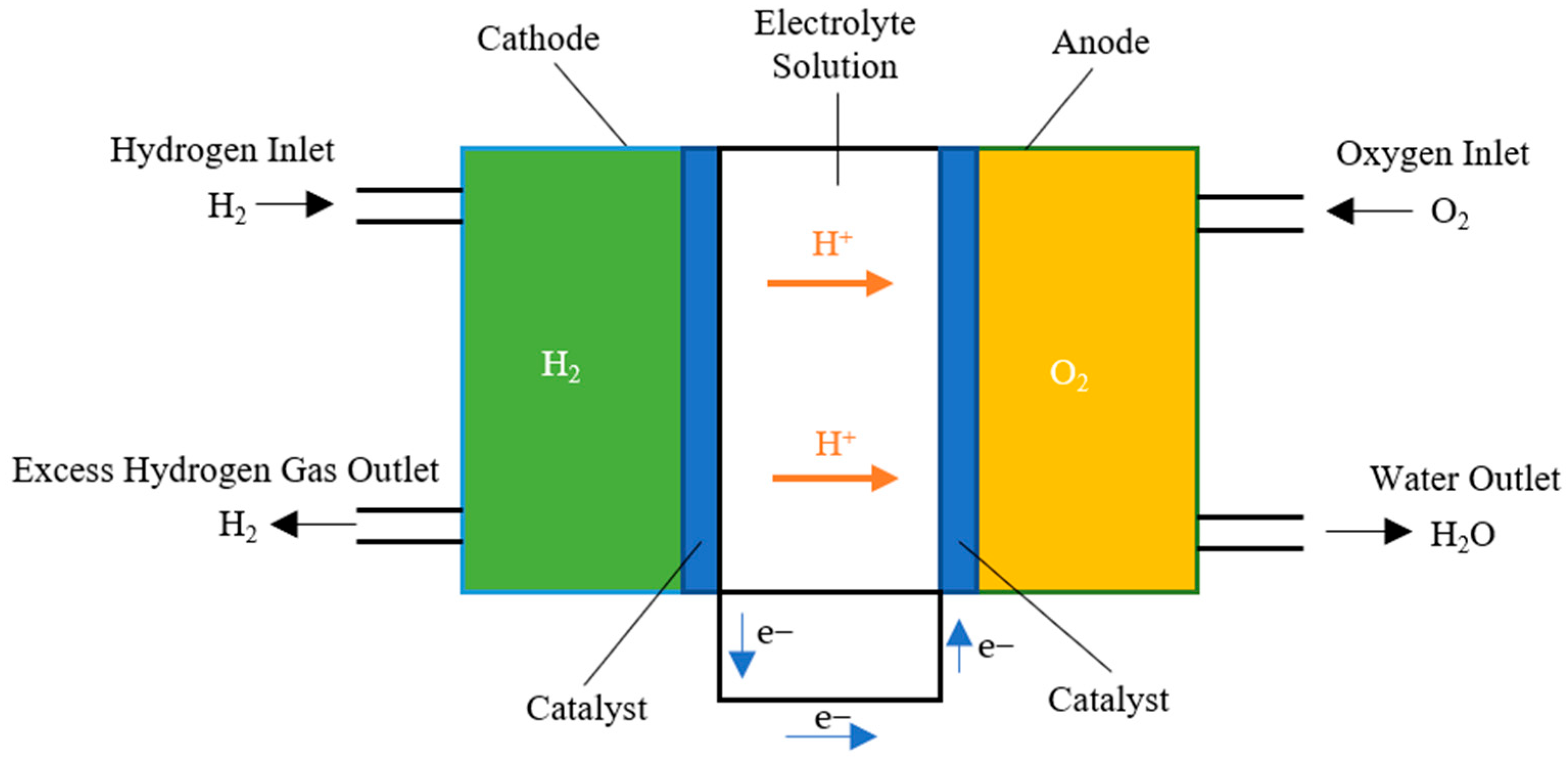
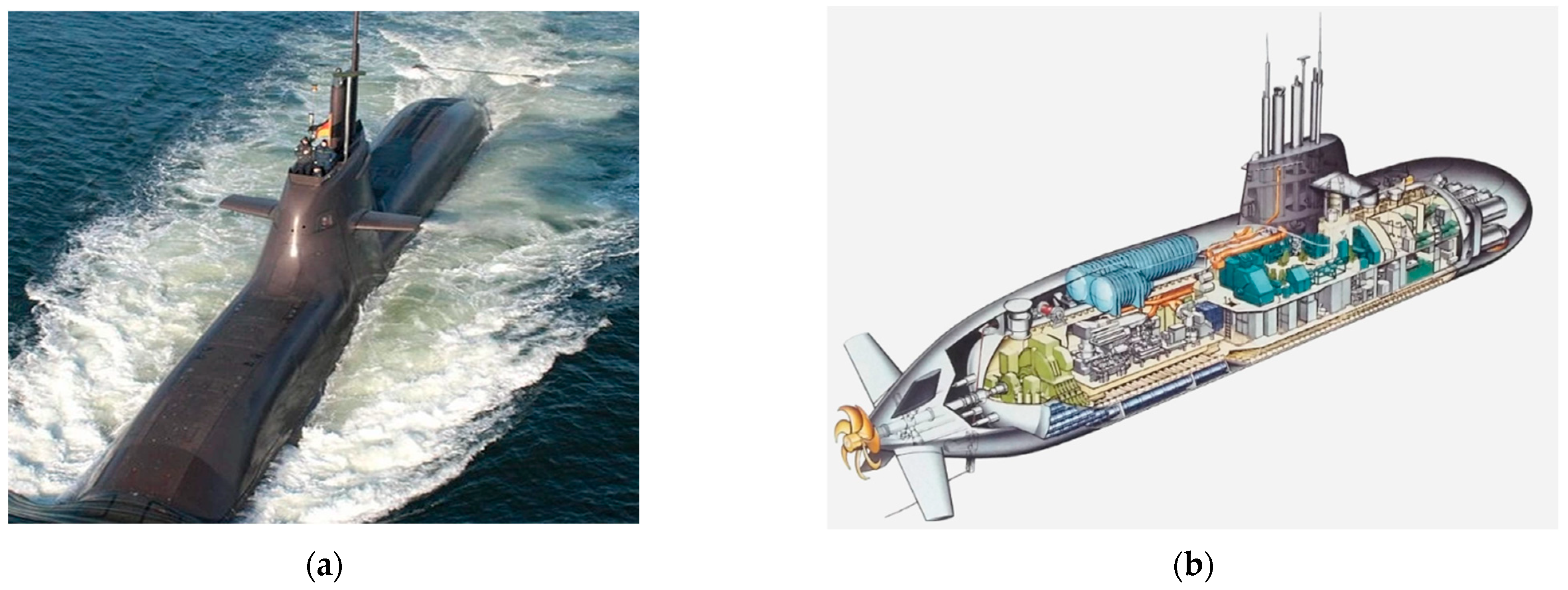


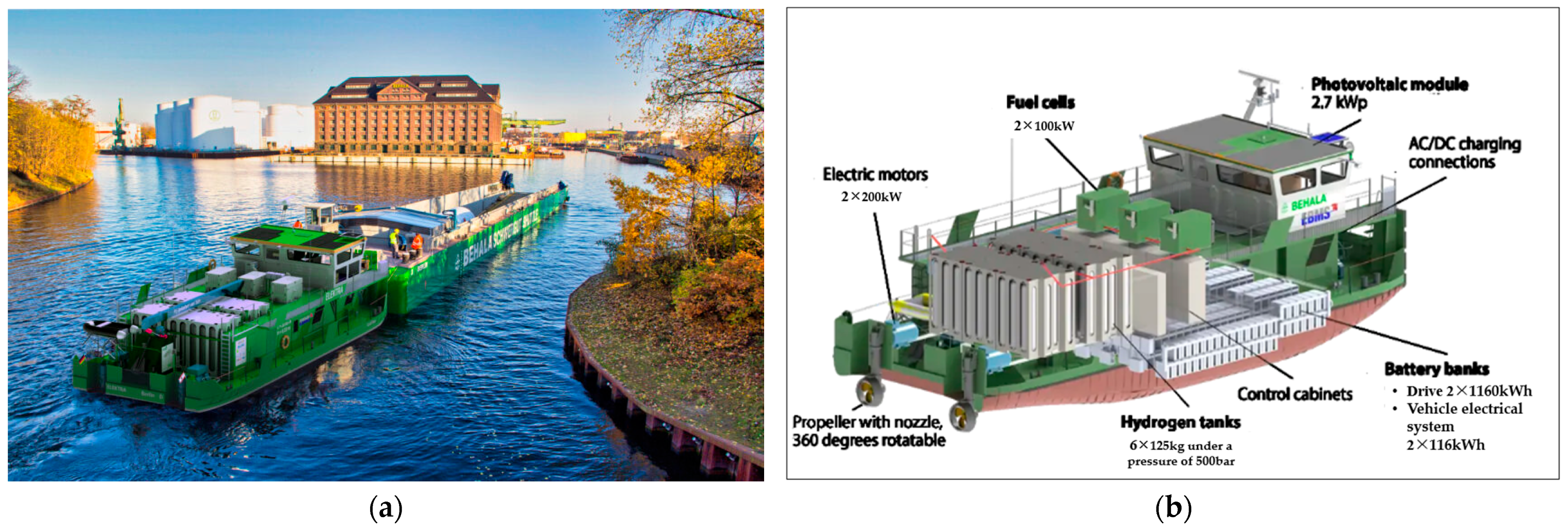
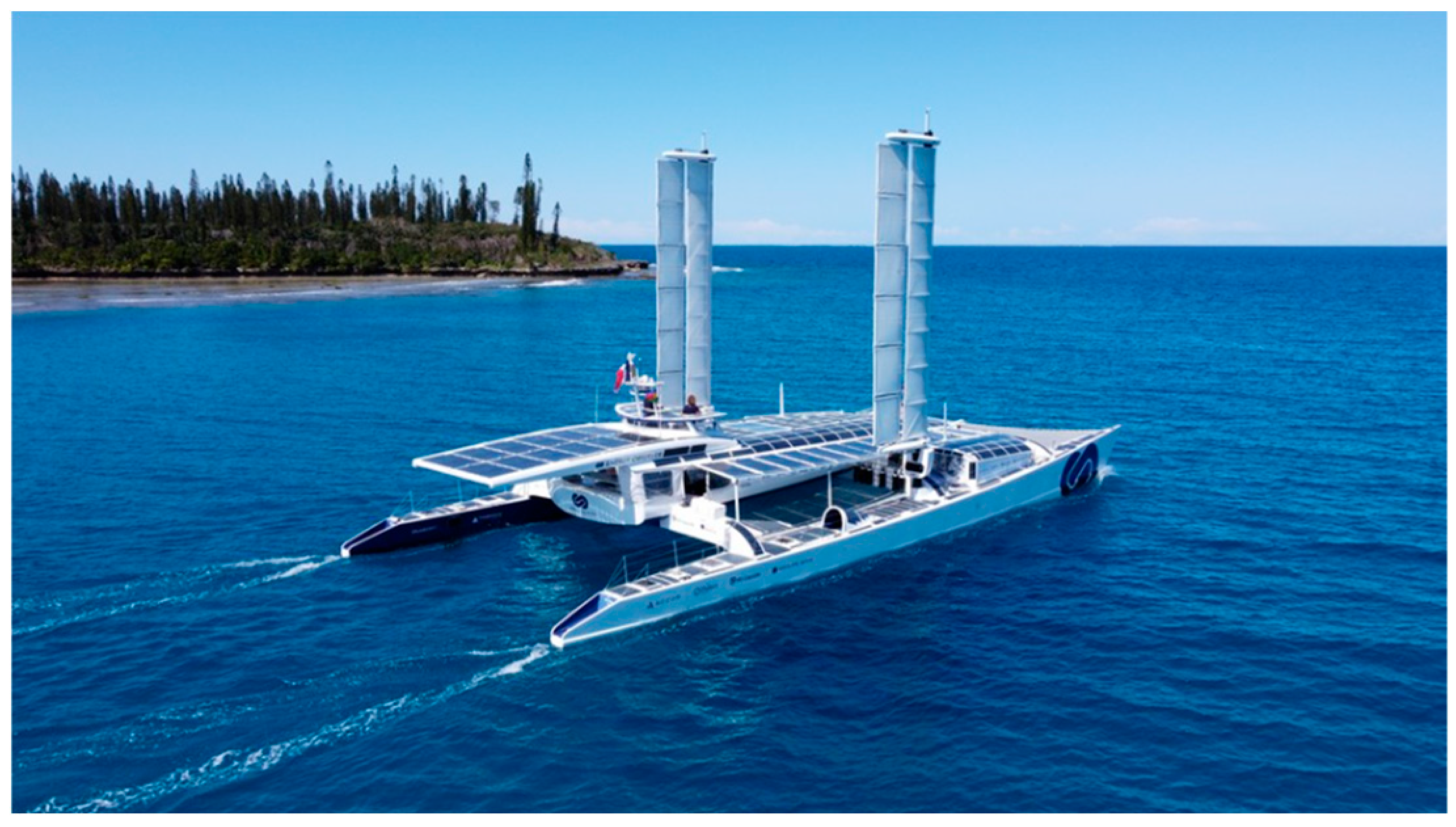
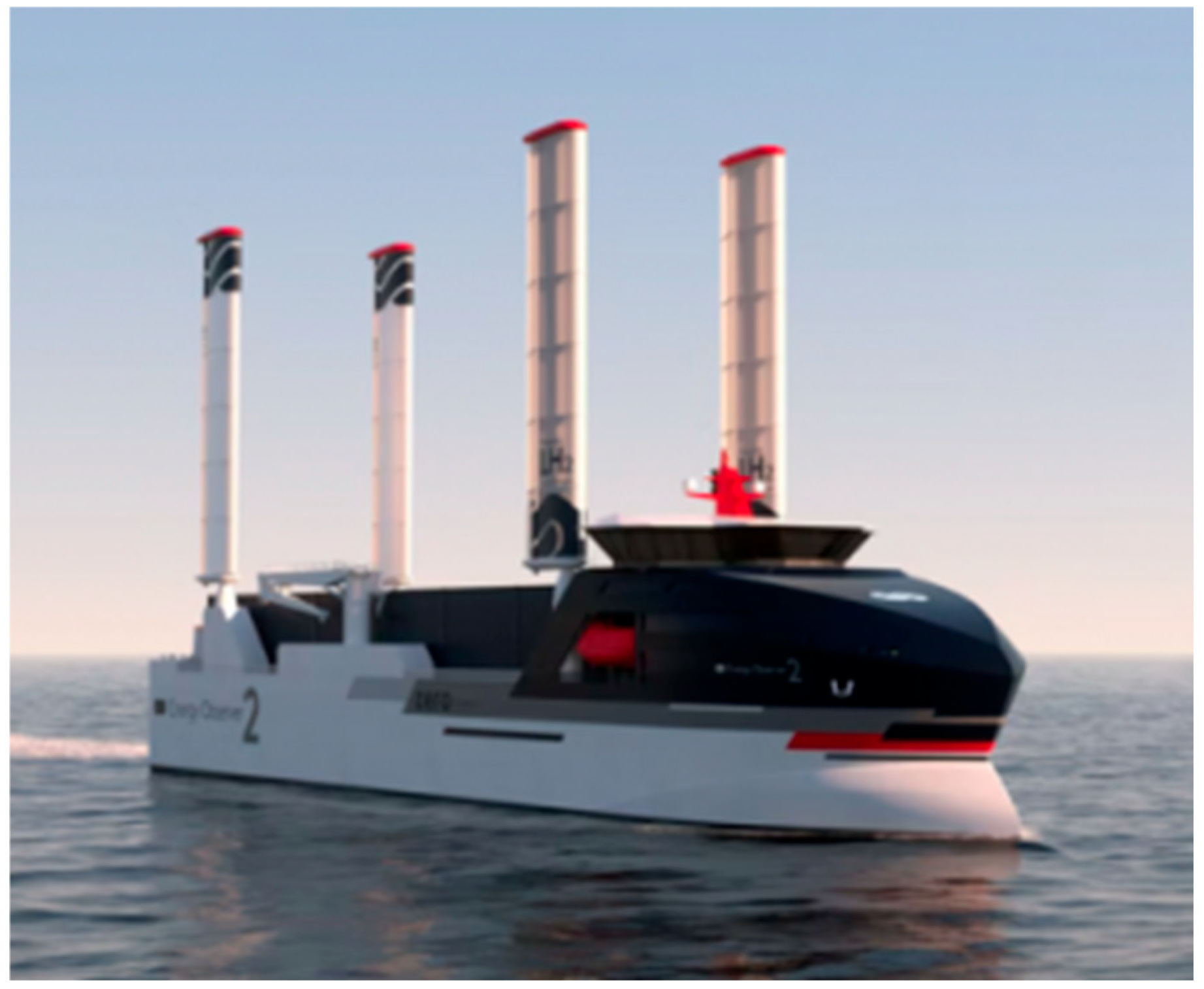




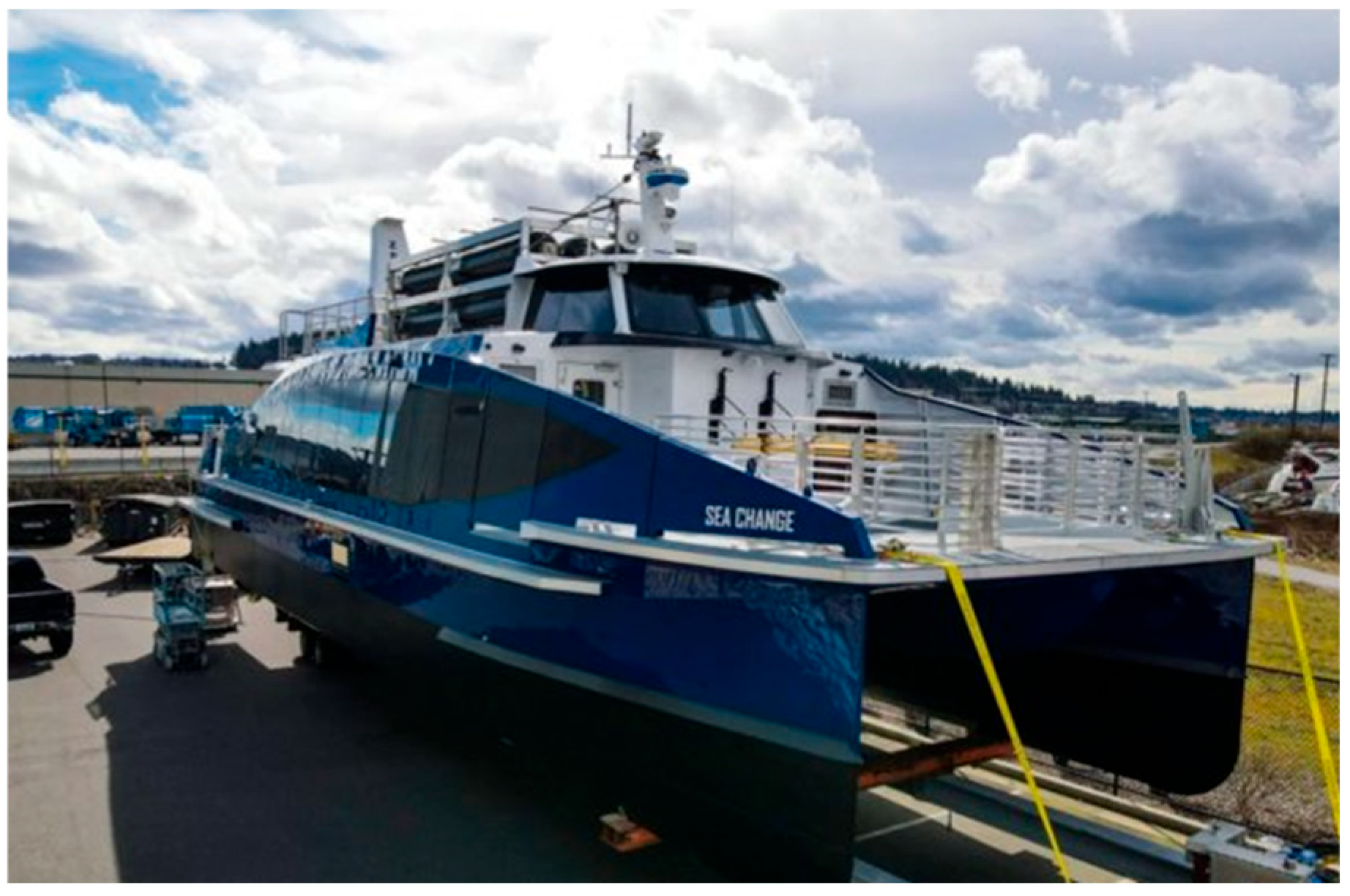
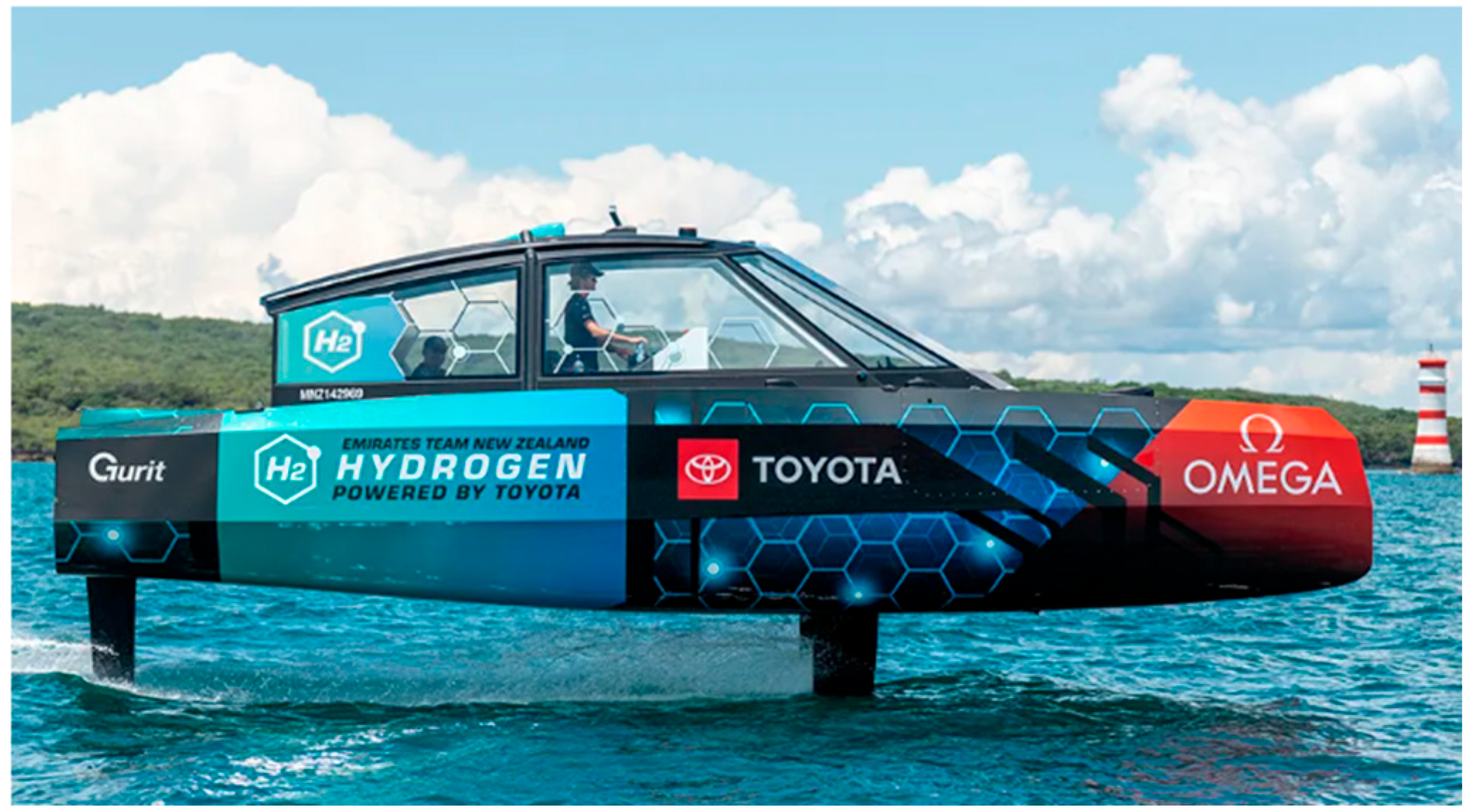
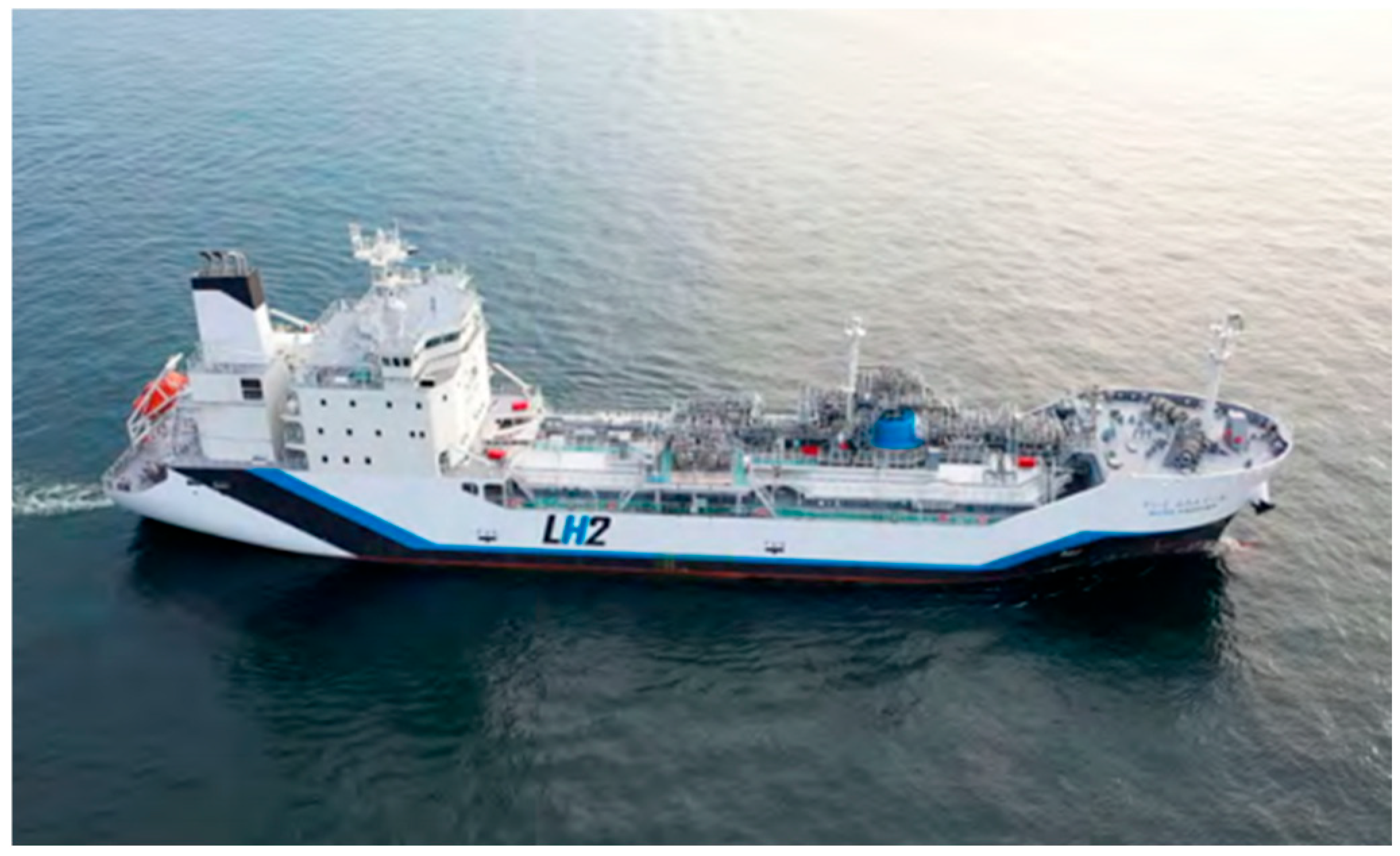

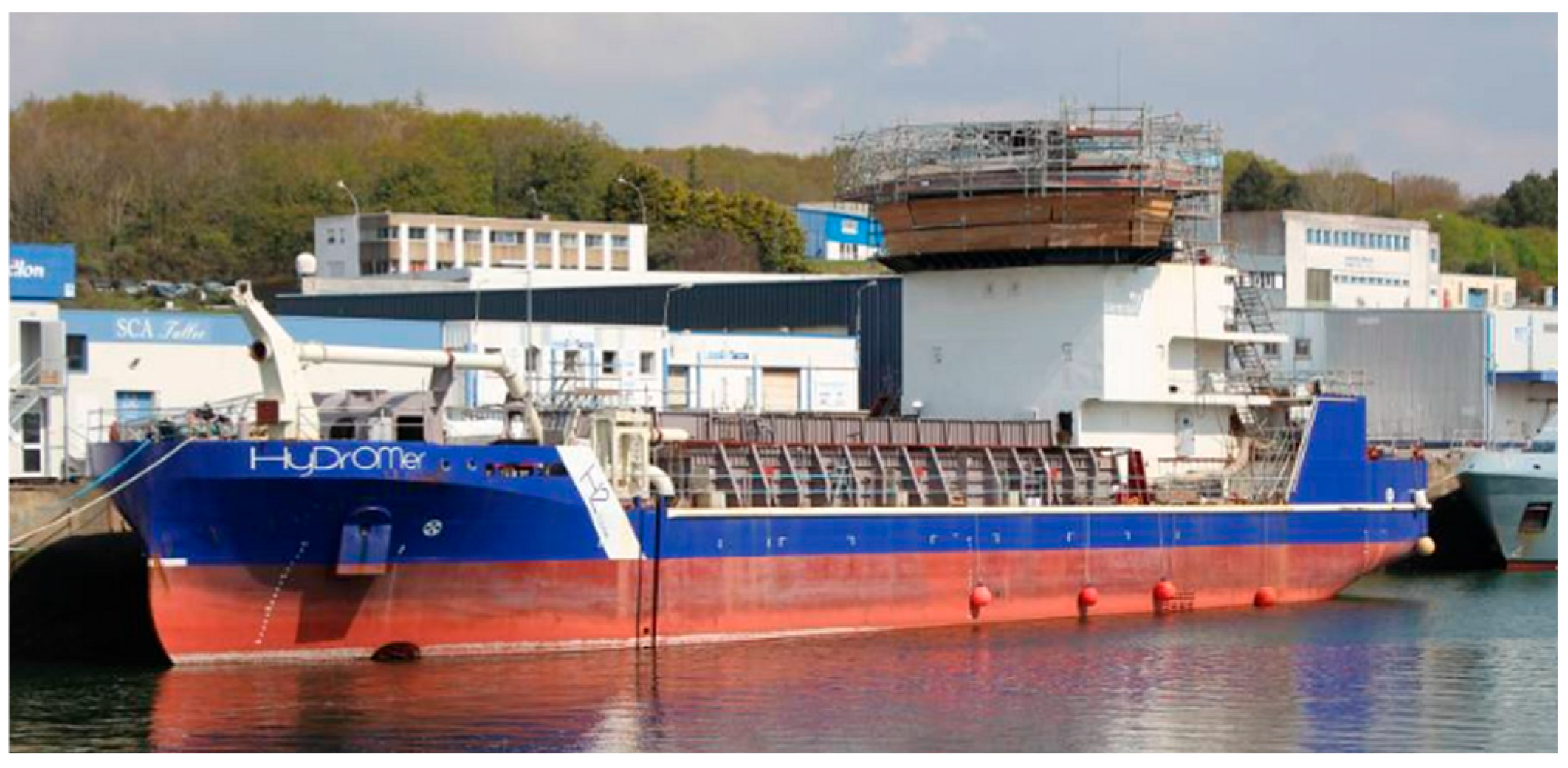
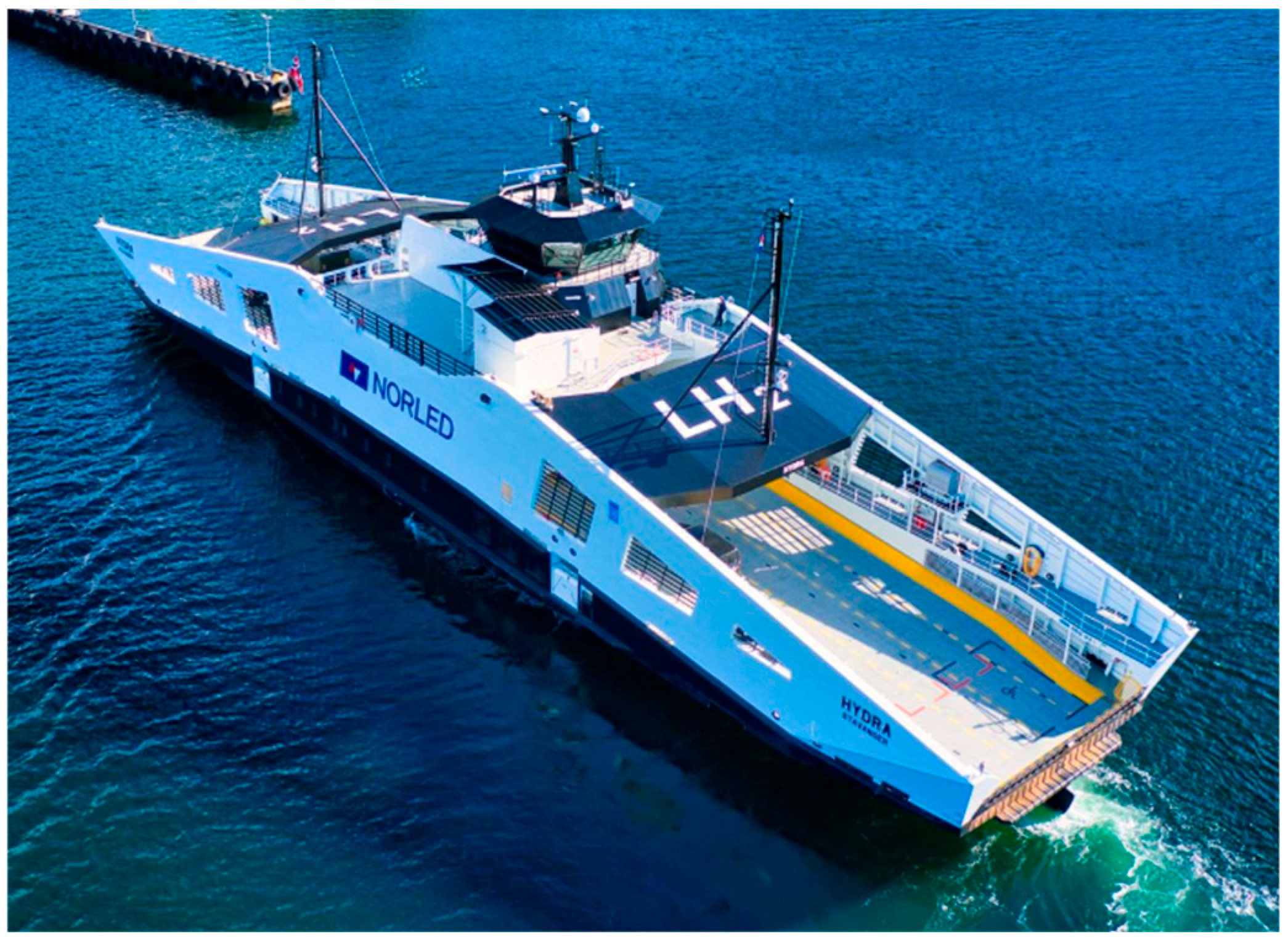
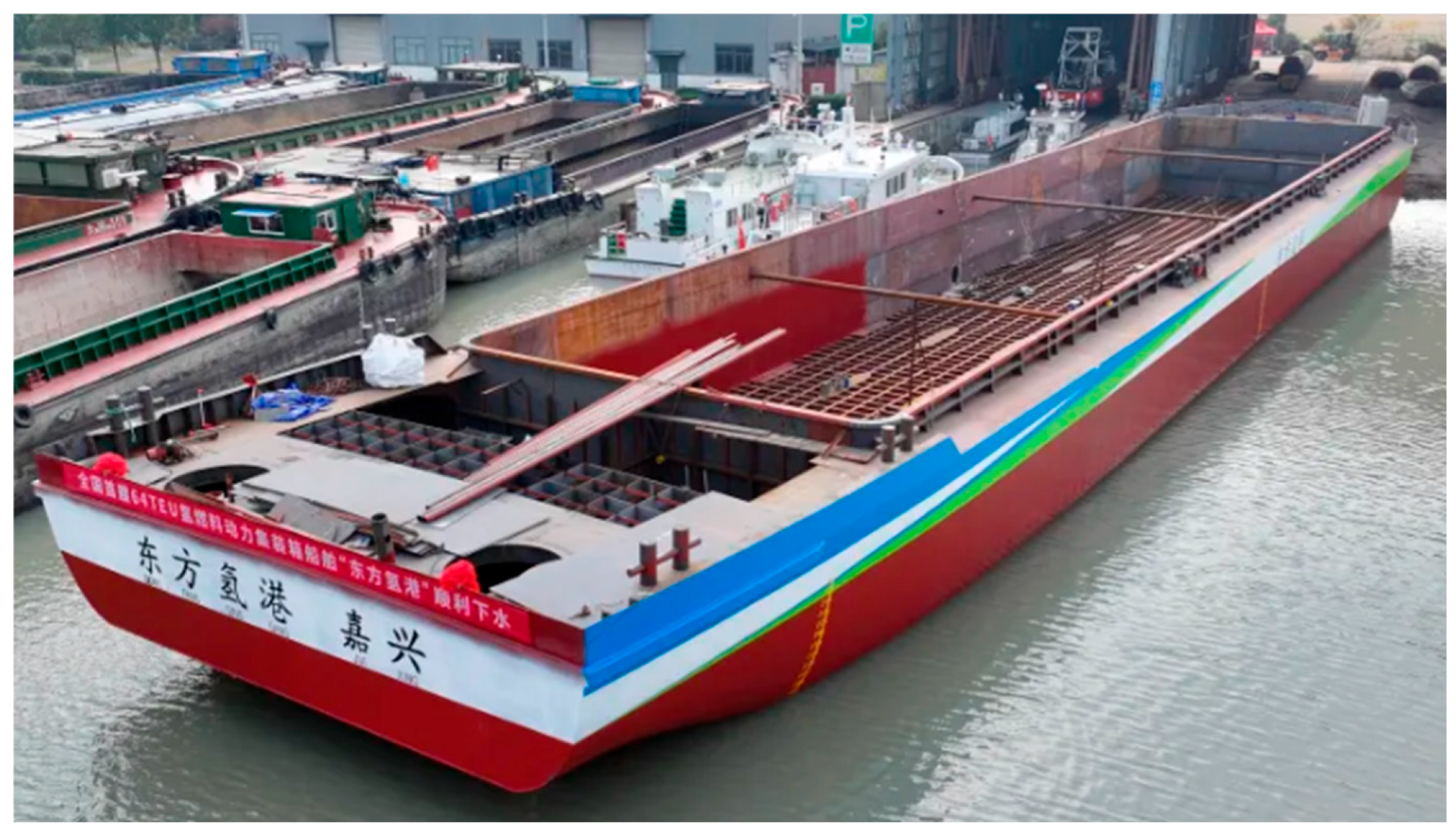
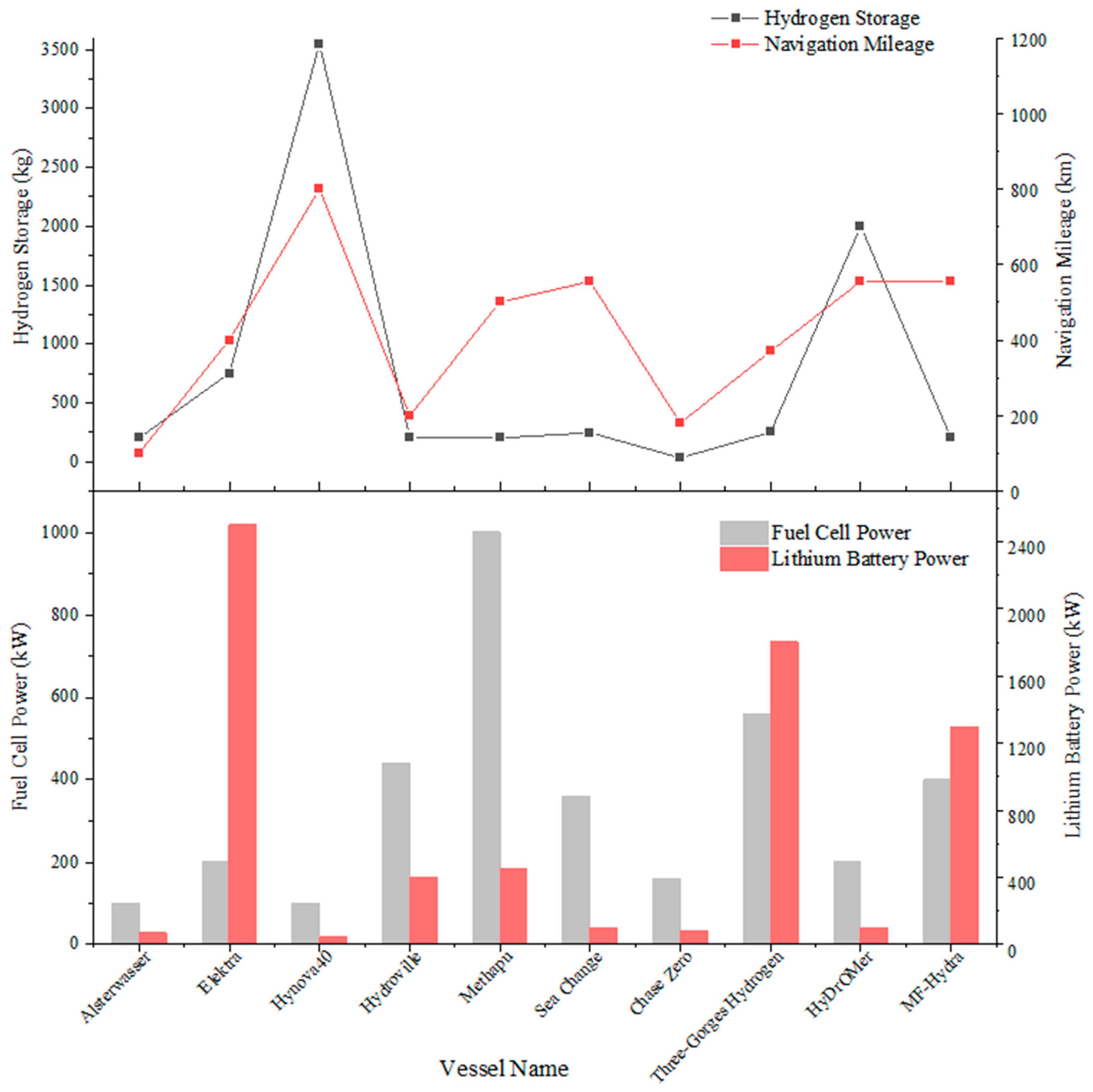

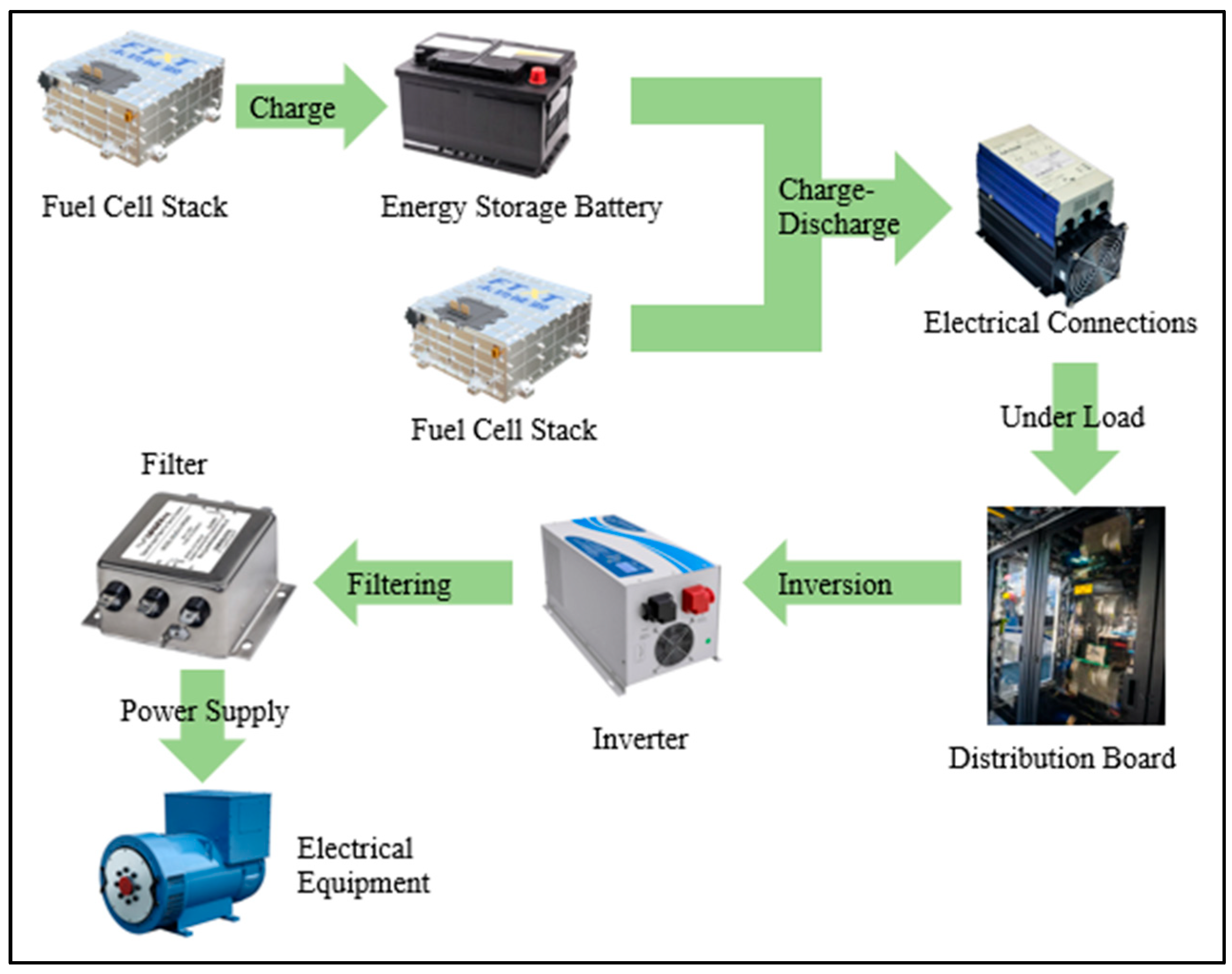
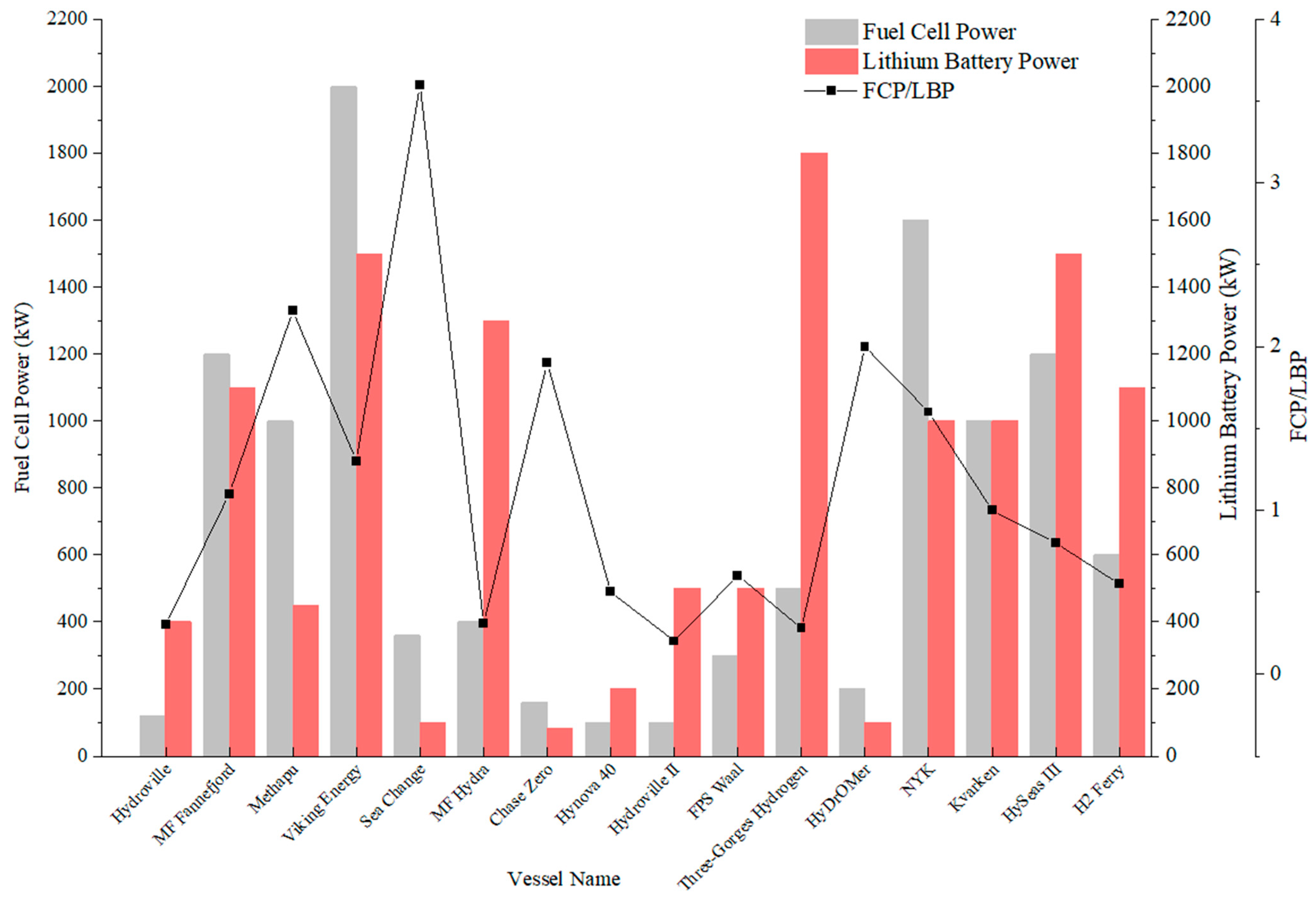
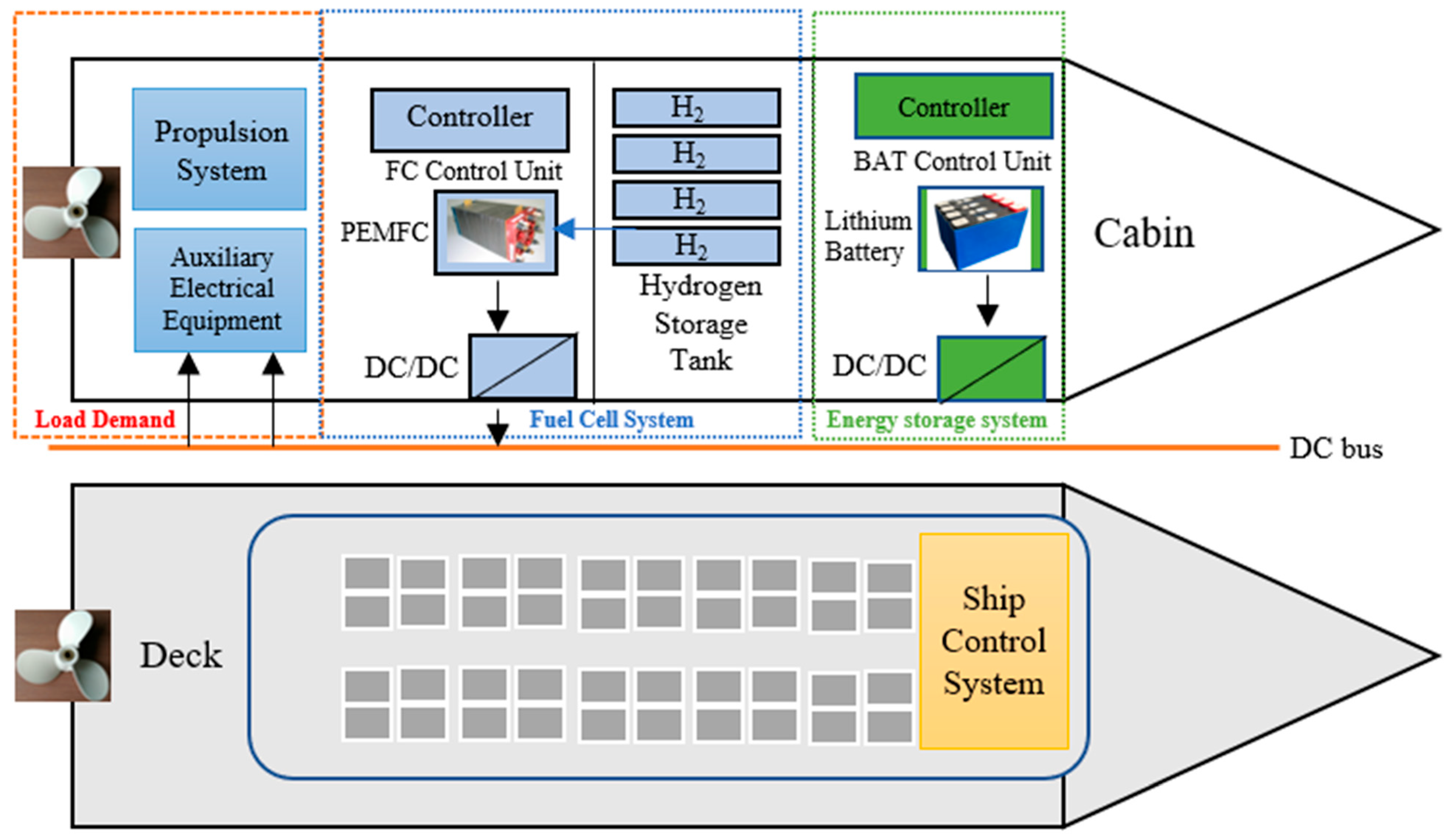
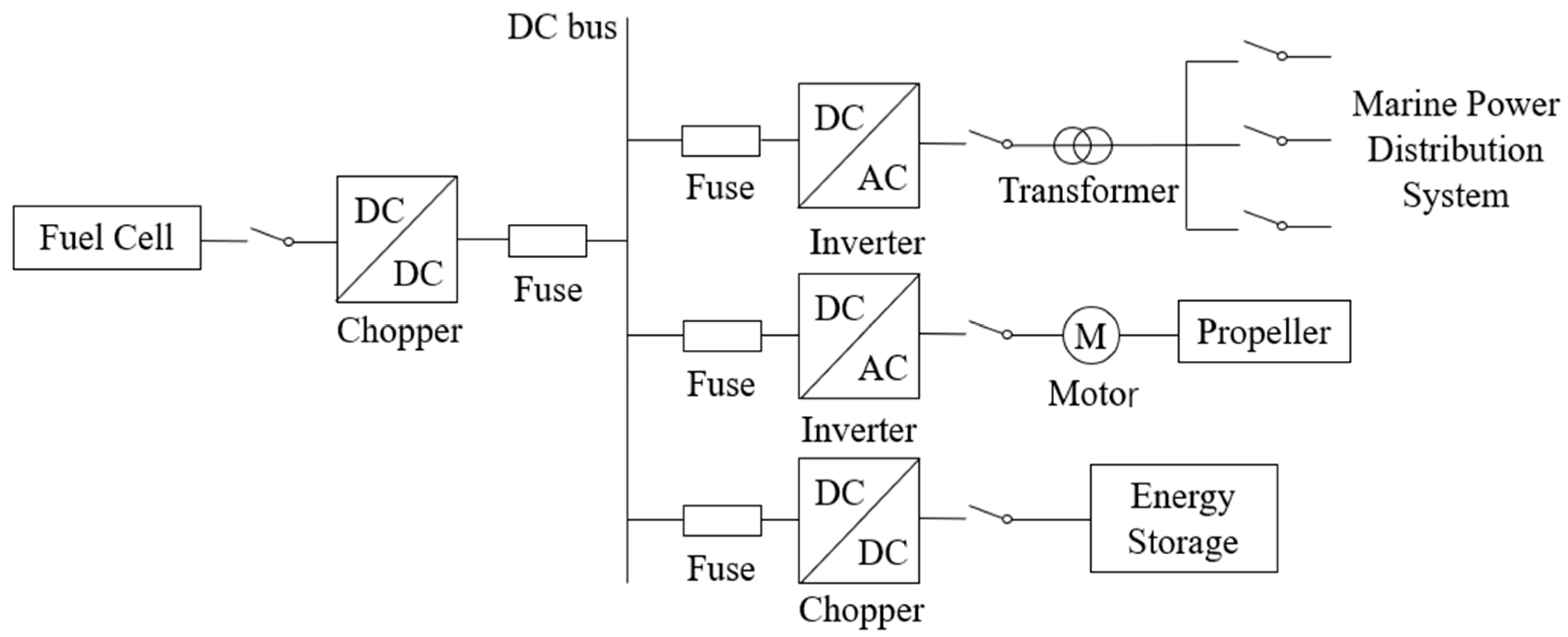




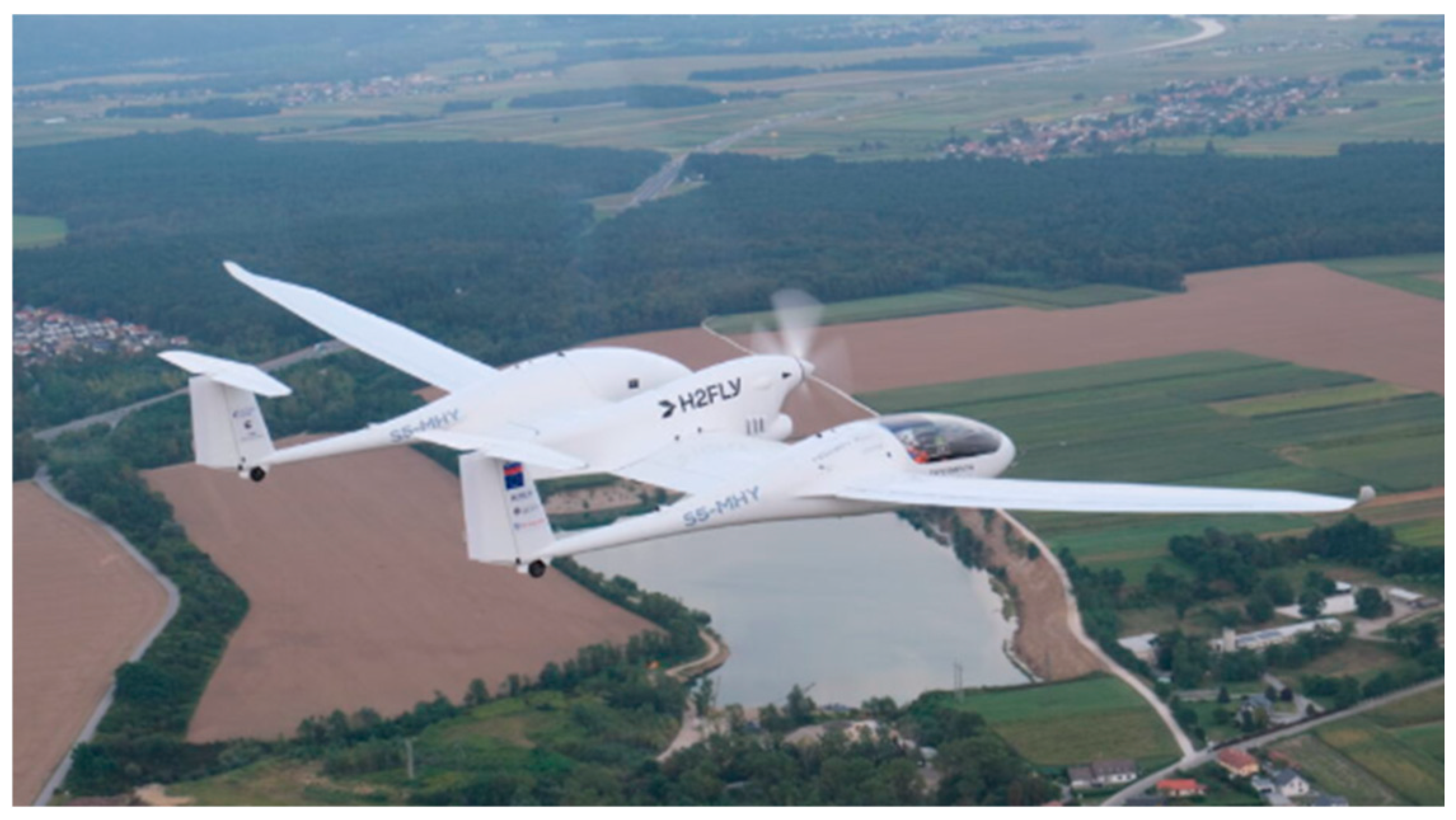
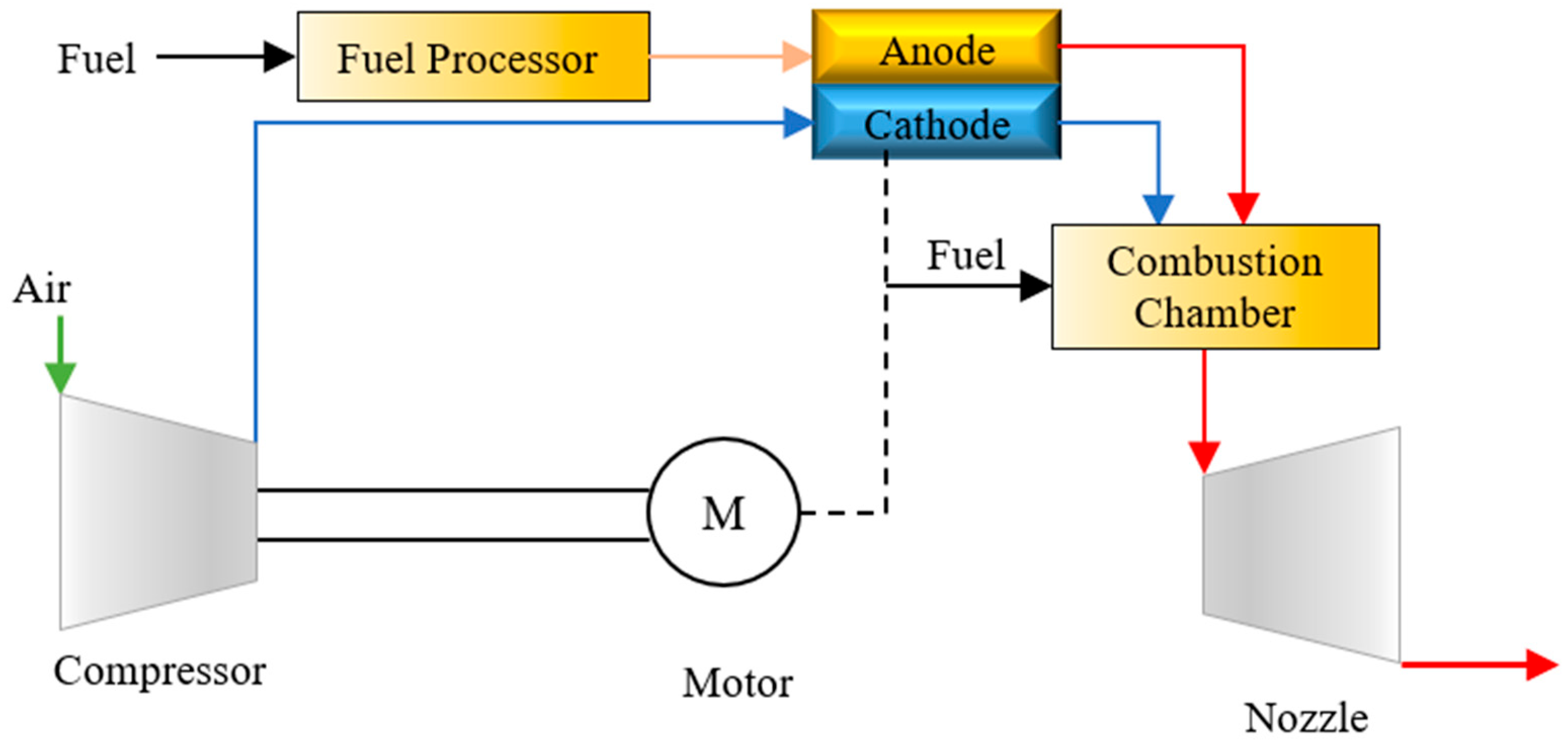
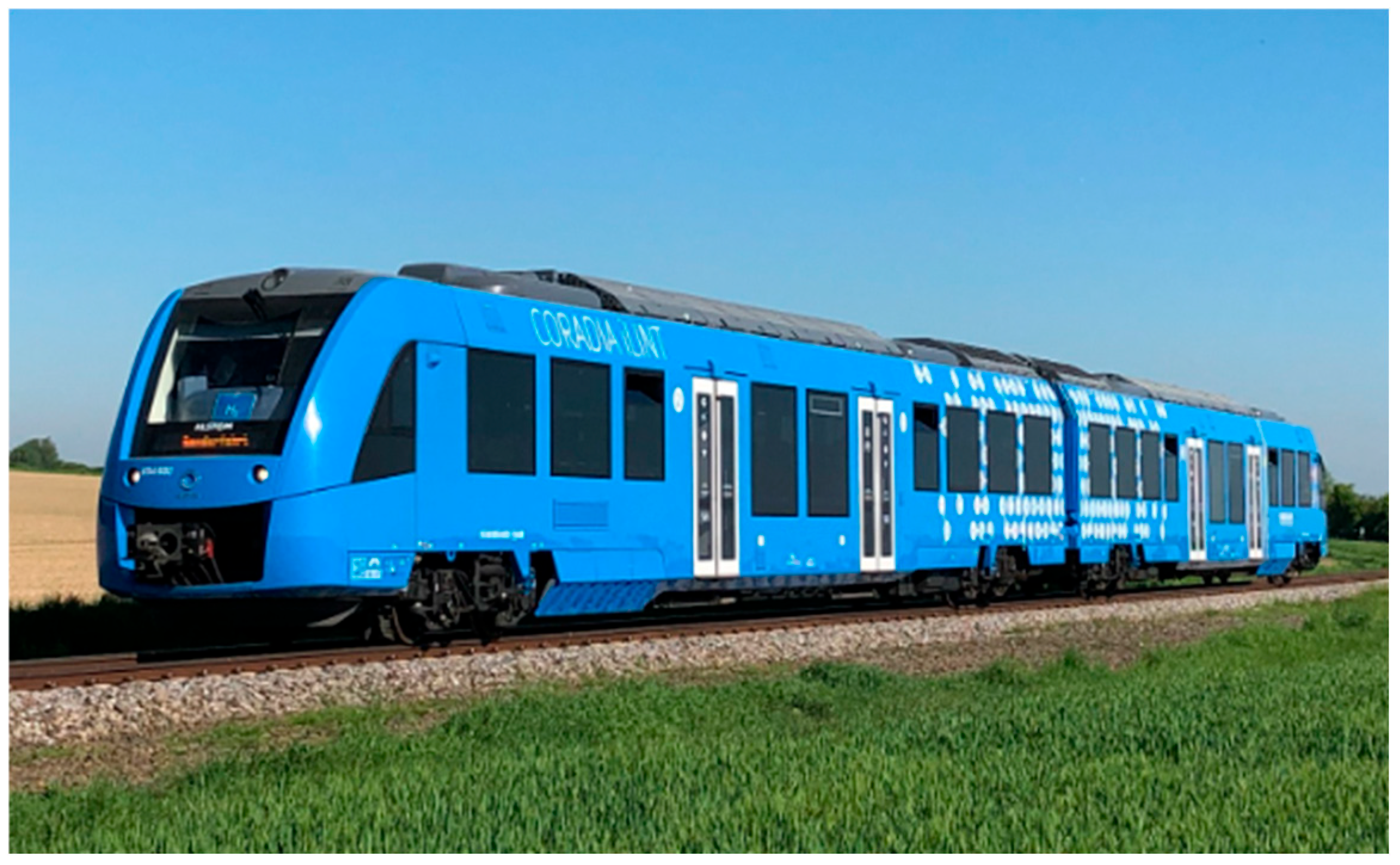
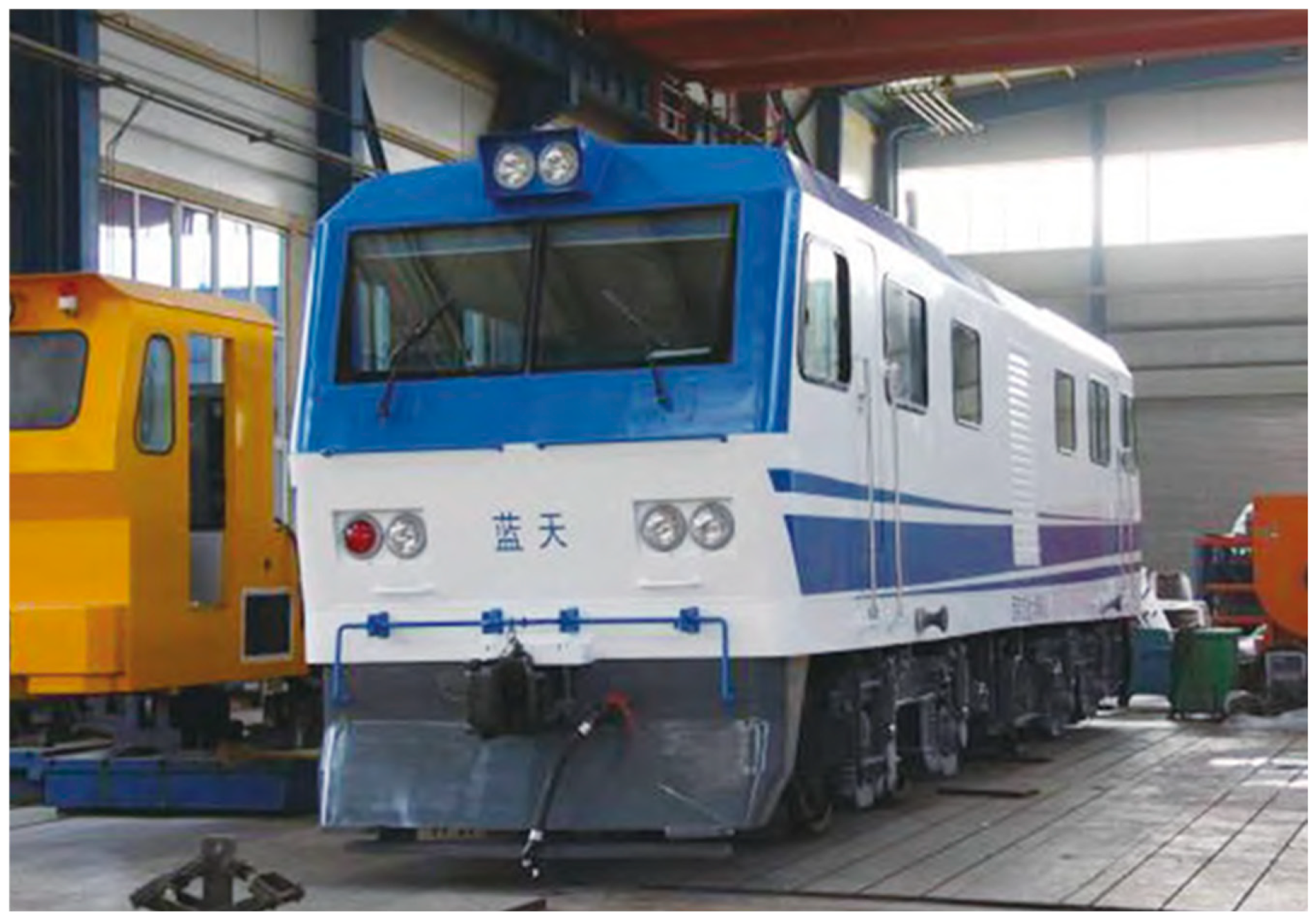


| Types of Fuel Cells | Temperature (°C) | Electrolyte | Efficiency | Lifetime (h) | Cost ($/kW) | Advantage | Disadvantage | Application Area |
|---|---|---|---|---|---|---|---|---|
| PEMFC | 60–200 °C | PEM | 40–60% | 5000–10,000 h | 40–60 $/kW | Low temperature and long service life | Sensitive to CO; High cost | Aerospace military, vehicle |
| AFC | 50–200 °C | Potassium hydroxide solution | 40–60% | 5000–20,000 h | 100–150 $/kW | Fast startup, high efficiency | Need pure oxygen as oxidant; Easy to corrode | Aerospace military |
| PAFC | 150–220 °C | Phosphoric acid solution | 40–50% | 40,000–60,000 h | 1000–2000 $/kW | Insensitive to CO | Low efficiency and easy corrosion | Vehicles, small and medium-sized power plants |
| SOFC | 800–1000 °C | Zirconia ceramics | 60–70% | 40,000–80,000 h | 1500–3000 $/kW | Wide fuel adaptability; Using non-noble metals as catalysts | High working temperature; Complex control and easy corrosion | Large power plants |
| MCFC | 650–750 °C | Alkaline phosphate | 50–60% | 20,000–40,000 h | 1000–3000 $/kW | Broad fuel flexibility; Utilization of non-precious metal catalysts | High working temperature; Complex control and easy corrosion | Large power plant, fixed equipment |
| Hydrogen Storage Mode | Characteristic | Advantage | Disadvantage | Application Examples |
|---|---|---|---|---|
| High-pressure gaseous hydrogen storage | Hydrogen is compressed under high pressure to store hydrogen in high-density gaseous form. The common pressure level is 350 bar or 700 bar. | With low cost and energy consumption, it is the most widely used hydrogen storage technology at present. | The hydrogen storage tank is susceptible to pressure and volume limitations; energy loss is significant, as the high-pressure compression process consumes a large amount of energy; and the storage density is low. | Finnish Arctic research vessel “Aranda”; French catamaran “Energy Observer”; The “Li Lake Future” of China and the ship “Elektra” of Germany; “Sea Change” ferry, etc. |
| Cryogenic liquid hydrogen storage | Cool the hydrogen to −253 °C, convert it into liquid and store it in a low-temperature insulated container. | It has a higher energy bulk density and stores more hydrogen energy in a smaller volume. It is suitable for large-scale storage and long-time navigation. | High cost of low-temperature cooling: hydrogen liquefaction process needs to consume a lot of energy; Volatile loss requires precise control system. | “SF-BREEZE” high speed ferry of the United States; “Zero-V” project in the United States Norway “M/F Hydra” ro-ro passenger ship; Norway “Topeka” Ro-ro ship |
| Metal hydrides | By reacting hydrogen with metal hydride to form solid hydride, hydrogen can be released when needed. | High safety, not easy to leak or explode; High storage density | Slow release speed; high cost; the technology is not yet fully mature. | German “212-A” submarine; Test vessel “Zeus” of Italy; Netherlands “Neo Orbis” demonstration ship |
| Energy Storage Category | Flywheel | Lithium-Ion Battery | Super Capacitor |
|---|---|---|---|
| Energy Storage Form | machinery | chemistry | electric field |
| Energy Density (W/kg) | 100–150 | 100–130 | 5–15 |
| Power Density (W/kg) | 5000 | 400–800 | 300–5000 |
| Efficiency (%) | 90 | 65–75 | 95 |
| Cycle Life (Times) | Approximately 100,000 | LiFePO4: 2000–5000 NMC or NCA, etc.: 500–2000 | Greater than 500,000 |
| Advantage | High power density, high energy density and high energy conversion rate | Various types, technologically mature, relatively low cost, and rapid development. | High power density, long service life, strong peak shaving capability |
| Disadvantage | Poor economic efficiency, large volume and weight | Prominent safety issues, shorter lifespan | Electrolyte leakage, poor energy storage capacity, high cost |
| Application Scenarios | Grid peak shaving, UPS | Electric vehicles, UPS | Grid peak shaving, load smoothing, rail transit |
| Vessel Name | Propulsion Mode of Power System |
|---|---|
| Viking Lady | Fuel Cell, Energy Storage Device, and Internal Combustion Engines in Parallel Power Supply |
| Alsterwasser | Fuel Cell and Energy Storage Device Dual-Drive Mode |
| Elektra | Fuel Cell and Energy Storage Device Dual-Drive Mode |
| Energy Observer | Fuel Cell and Energy Storage Device Dual-Drive Mode |
| Energy Observer Ⅱ | Fuel Cell and Energy Storage Device Dual-Drive Mode |
| Hydroville | Fuel Cell, Energy Storage Device, and Internal Combustion Engines in Parallel Power Supply |
| AIDAnova | Fuel Cell, Energy Storage Device, and Internal Combustion Engines in Parallel Power Supply |
| MF Fannefjord | Fuel Cell, Energy Storage Device, and Internal Combustion Engines in Parallel Power Supply |
| Viking Energy | Fuel Cell, Energy Storage Device, and Internal Combustion Engines in Parallel Power Supply |
| Sea Change | Fuel Cell and Energy Storage Device Dual-Drive Mode |
| Suiso Frontier | Fuel Cell, Energy Storage Device, and Internal Combustion Engines in Parallel Power Supply |
| Chase Zero | Fuel Cell and Energy Storage Device Dual-Drive Mode |
| Three Gorges Hydrogen Ship 1 | Fuel Cell and Energy Storage Device Dual-Drive Mode |
| HyDrOMer | Fuel Cell, Energy Storage Device, and Internal Combustion Engines in Parallel Power Supply |
| MF-Hydra | Fuel Cell and Energy Storage Device Dual-Drive Mode |
| Eastern Hydrogen Port | Fuel Cell and Energy Storage Device Dual-Drive Mode |
| Fuel Cell Category | Marine Fuel Cells | Automotive Fuel Cells |
|---|---|---|
| Application Instructions for Ship/Vehicle Fuel Cells | Fuel cell vehicles generate electricity through a fuel cell to drive the motor and make the vehicle operate. The requirements for these fuel cells are high efficiency, quick response, and compact size and weight to meet the demands of high-speed driving and acceleration. Since vehicles need to output high power instantaneously for acceleration, the fuel cell needs to have a rapid response capability in such situations, and power fluctuations should be minimized. The fuel cell system for vehicles requires high integration, as well as high demands on heat management, efficiency, and continuous operation [136]. | Marine fuel cells, as a new power source to replace traditional diesel generators and gas turbines, are primarily used as power stations on ships to provide continuous electrical power for the entire vessel. Given the large size of ships and the complexity of the sailing environment, marine power stations require higher stability and continuity. Fuel supply on ships typically uses large capacity high-pressure hydrogen storage tanks or liquid hydrogen to support long-duration voyages. Additionally, marine fuel cell systems involve more auxiliary systems, such as cooling systems, power distribution systems, and navigation/communication systems. The systems are relatively complex and require multiple fuel cell modules working together. |
| Fuel Cell Category | Marine Fuel Cells | Automotive Fuel Cells |
|---|---|---|
| System Test—Environmental Adaptability Test Items | Insulation Resistance Measurement Voltage Withstand Test Power Fluctuation Test Power Failure Test Tilt and Sway Test Vibration Test High-Temperature Test Low-Temperature Test Damp Heat Test Enclosure Protection Test Electromagnetic Compatibility Test Flame Arrest Test Salt Spray Test | Performance Test Flame Arrest Test Dust Protection Test High- and Low-Temperature Test Waterproof Test Tilt Test Vibration Test Electromagnetic Compatibility Test Damp Heat Test |
| Hydrogen Storage Method | High-Pressure Hydrogen Storage | Liquid Hydrogen | Solid Metal Hydrogen Storage | Organic Liquid Hydrogen Storage | Methanol Reforming for Hydrogen Production |
|---|---|---|---|---|---|
| Quality Hydrogen Storage Density (wt%) | 3.5~5.7 | >10 (depending on energy storage) | 1.0~1.8 | 3.0~4.0 | 4.0~6.0 |
| Volume Hydrogen Storage Density (g/L) | 19~39 | ~70 | 60–80 | 40~50 | 60~70 |
| Advantage | Mature technology, simple equipment structure, and low cost | High hydrogen storage density | Good safety, high volumetric hydrogen storage density | Liquid hydrogen storage at room temperature and pressure has a high density | High hydrogen storage density, convenient refueling, low raw material cost |
| Disadvantage | High pressure, safety risks, low volumetric hydrogen storage density | Liquefaction requires significant energy; high daily evaporation rate | Low-mass hydrogen storage density, high cost | Hydrogenation and dehydrogenation require energy consumption, high cost | Large CO₂ emissions, hydrogen contains impurities |
| Applications | Small and medium-sized surface vessels | Ocean-going transport vessels, liquid hydrogen storage and transport vessels | Underwater equipment, surface vessels | Transport vessels for large-scale hydrogen storage and transport | Surface vessels with no zero-emission requirements |
| Fuel Cell Category | Application Environment Differences |
|---|---|
| Marine Fuel Cells | Marine fuel cells are primarily used in oceanic environments, which present highly complex operating conditions. They often face harsh weather, such as wind, waves, salt spray, and seawater corrosion. During navigation, ships experience rolling, vibrations, high humidity, and salt-laden air. Salt spray and moisture in marine environments can accelerate corrosion in fuel cell system pipelines, damaging the fuel cell stack and potentially leading to hydrogen leaks or combustion incidents. Therefore, marine fuel cells must possess strong anti-interference capabilities, operate stably over extended periods, and provide sufficient power to support long-distance voyages. |
| Aviation Fuel Cells | Aviation fuel cells are designed for high-altitude flight and must function in low-temperature, high-altitude, low-pressure environments with significant temperature fluctuations during flight. At high altitudes, external temperatures can drop to −50 °C, requiring the fuel cells to remain stable under these extremes. During flight, the low oxygen concentration in the air, combined with high-speed travel, imposes stringent demands on the oxygen supply system. Additionally, the aerodynamic pressure and vibrations experienced by aircraft differ from those of marine vessels, further challenging the durability and efficiency of aviation fuel cells [156]. |
| Fuel Cell Category | Fuel Selection |
|---|---|
| Marine Fuel Cells | Marine fuel cells typically use fuels such as hydrogen and methanol. During maritime navigation, hydrogen storage is often achieved using high-pressure gas cylinders or liquid hydrogen storage tanks, which have large capacities to accommodate fuel for long-duration voyages. Methanol is also commonly used as an alternative to hydrogen due to its easier storage and better adaptability to low-temperature environments. |
| Aviation Fuel Cells | The energy demand for aviation fuel cells is highly sensitive to weight and volume, making the selection of fuel more cautious in the aviation sector. Hydrogen storage for aviation fuel cells typically uses ultra-high-pressure gas cylinders, but this storage method heavily relies on high-strength materials and advanced designs to ensure the stability of the storage system under high-altitude, low-temperature conditions. |
| Fuel Cell Category | Power Requirements |
|---|---|
| Marine Fuel Cells | The power demand for ships is typically large, requiring high-power fuel cell systems to meet multiple needs such as navigation and power generation. This is especially true for long-distance voyages, which require a continuous and stable energy supply. Therefore, fuel cell systems must possess high power density and long-lasting endurance capabilities. |
| Aviation Fuel Cells | Compared to marine fuel cells, aviation fuel cells have relatively smaller power demands, but the requirements for power density are extremely strict. Aircraft typically experience significant instantaneous power demands during takeoff and climb, requiring the power system to respond quickly. Unlike marine vessels, the aviation sector has more precise power requirements, and system optimization is necessary to maintain energy efficiency and extend endurance [158]. |
| Fuel Cell Category | System Design |
|---|---|
| Marine Fuel Cells | The size and weight of marine fuel cell systems have a relatively small impact on the vessel, and ships have lower requirements for the adaptability of fuel cell dimensions. The design of marine fuel cell systems focuses more on long-term, stable operation and higher power demands. Since ships typically need to operate on the sea for extended periods, system design places more emphasis on energy storage and management. On ships, fuel cell systems are not only used for propelling the vessel but are also commonly used to provide power for living facilities. Additionally, to address the risks of the unique marine environment, marine fuel cell systems are typically designed with redundancy to ensure that if one part of the system fails, it does not affect overall operation. |
| Aviation Fuel Cells | The design of aviation fuel cell systems places greater emphasis on lightweight construction and high efficiency. Fuel cells must not only meet the power requirements of the aircraft but also be integrated into the complex systems of the aircraft, such as propulsion and avionics. Every part of the aircraft must undergo precise weight and volume optimization, which makes the integration of aviation fuel cells highly demanding [159]. |
Disclaimer/Publisher’s Note: The statements, opinions and data contained in all publications are solely those of the individual author(s) and contributor(s) and not of MDPI and/or the editor(s). MDPI and/or the editor(s) disclaim responsibility for any injury to people or property resulting from any ideas, methods, instructions or products referred to in the content. |
© 2025 by the authors. Licensee MDPI, Basel, Switzerland. This article is an open access article distributed under the terms and conditions of the Creative Commons Attribution (CC BY) license (https://creativecommons.org/licenses/by/4.0/).
Share and Cite
Zhang, Z.; Zheng, X.; Cui, D.; Yang, M.; Cheng, M.; Ji, Y. Research Progress of Fuel Cell Technology in Marine Applications: A Review. J. Mar. Sci. Eng. 2025, 13, 721. https://doi.org/10.3390/jmse13040721
Zhang Z, Zheng X, Cui D, Yang M, Cheng M, Ji Y. Research Progress of Fuel Cell Technology in Marine Applications: A Review. Journal of Marine Science and Engineering. 2025; 13(4):721. https://doi.org/10.3390/jmse13040721
Chicago/Turabian StyleZhang, Zheng, Xiangxiang Zheng, Daan Cui, Min Yang, Mojie Cheng, and Yulong Ji. 2025. "Research Progress of Fuel Cell Technology in Marine Applications: A Review" Journal of Marine Science and Engineering 13, no. 4: 721. https://doi.org/10.3390/jmse13040721
APA StyleZhang, Z., Zheng, X., Cui, D., Yang, M., Cheng, M., & Ji, Y. (2025). Research Progress of Fuel Cell Technology in Marine Applications: A Review. Journal of Marine Science and Engineering, 13(4), 721. https://doi.org/10.3390/jmse13040721











